April 9 - 22, 2017: Issue 308
Ron Turton
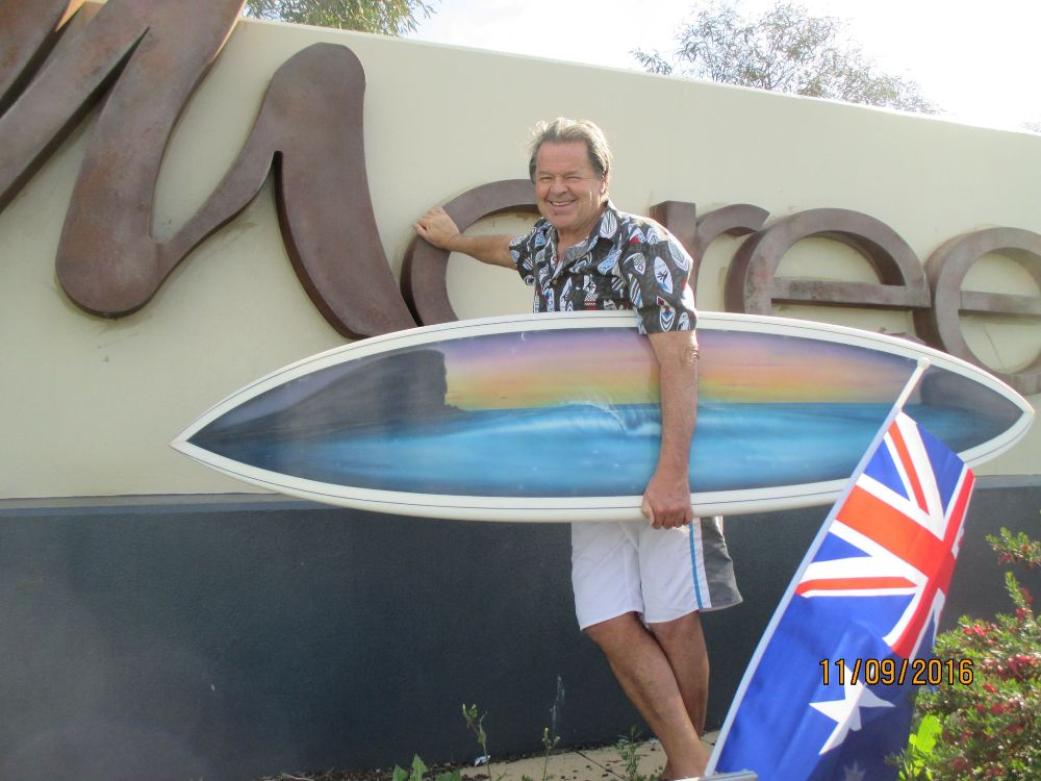
Ron Turton has been halfway around the world and back, twice!
A gentleman who has a deep and abiding love of the sea and countryside, he was among those young Australians who took to surfing in the 1950's and saw surfing evolve into the worldwide phenomenon it remains today. He is among those who surfed Palm Beach as part of the 'Beachcombers' crew and surfboard riding club.
Ron has also seen the changes that have occurred in newspapers with almost five decades of experience in rural and metropolitan print media on the advertising side of these. He was in the first year of Avalon Beach Public school when that opened, and in the first intake of Narrabeen Boys High School when that opened. A motto he has lived his life by is from his short time at Manly Boys High School when there that educational font in our community was still 'just for boys'.
In keeping with that, Mr. Turton shares some of what he has received and learned along the way:
Where and when were you born?
I was born in Woking, and the family lived in Thames Ditton in Surrey in 1945. We came out here in 1949.
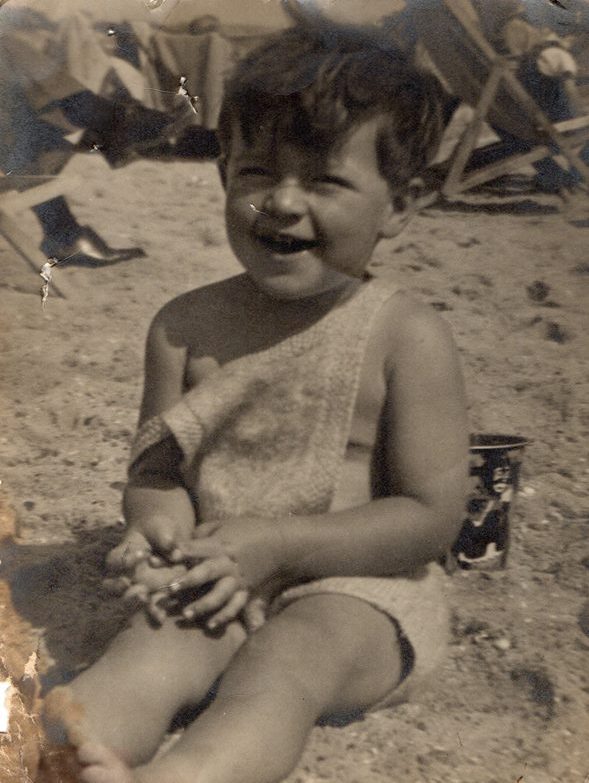
Ron in England aged three; 'Now do I want to go to the beach here and sit in a deck chair wearing long trousers, sandles and socks when I grow up or go to the Land Down Under to Palm Beach?'
Dad, Ronald Charles Turton DFC (Distinguished Flying Cross), was a fighter pilot with the 618 Squadron RAF, he got through. By the way, the 617 Squadron were the Dam Busters; there’s a book called ‘A Most Secret Squadron’. It was a toss-up who did the bombings. When Wing Commander Guy Penrose Gibson, VC, DSO & Bar, DFC & Bar found out they were doing the dams, and not what dad’s squadron was doing, which was bombing the Tirpitz, the big German ship, he said ‘Thank God it’s not the Tirpitz’.
Both the 617 and 618 Squadrons were practicing the bouncing bombs. Dad's 618 Squadron never actually attacked the Tirpitz as when The Dambusters did their thing the Tirpitz attack was aborted even though they had done all the training.
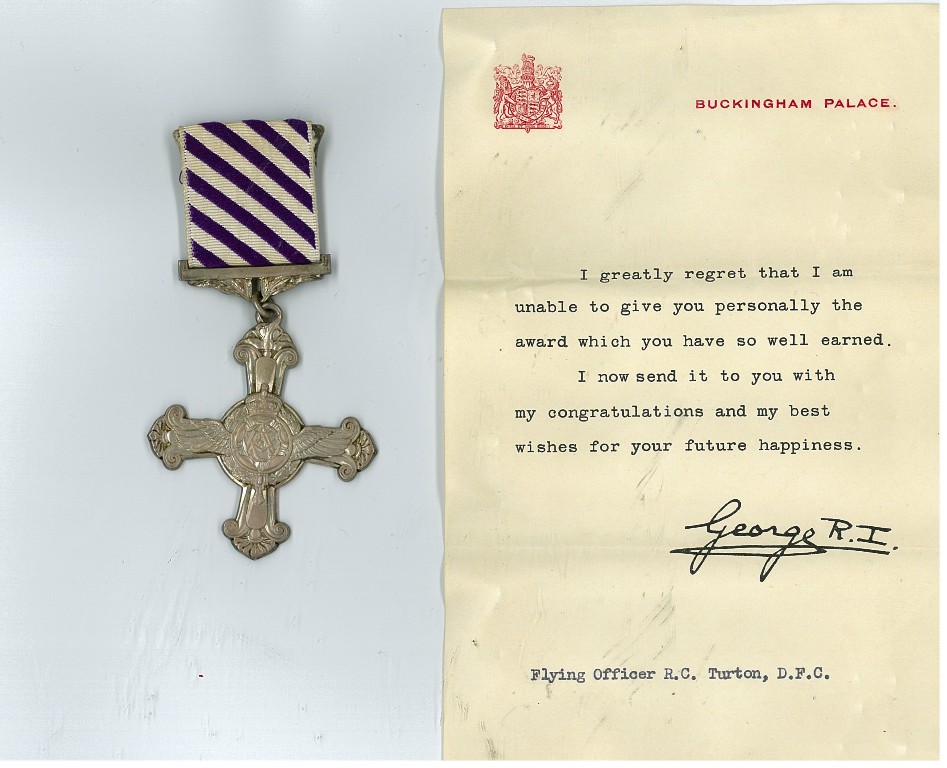
Dad's DFC and letter from the King: June 30th, 1944; Flying Officer, No. 149 Squadron, RAF
"Received in recognition of gallantry and devotion to duty in the execution of air operations."
(Fourth Supplement to The London Gazette of 27th June 1944, dated 30th June 1944, Issue 36589, Page 3090)
When the war finished in Europe Dad’s squadron all hopped on an Aircraft Carrier with Mosquitoes and they ended up out at Narromine, a bit of change of scenery for many of them. I was born while dad was in Australia, June the 27th.
They were posted here ‘just in case’ – we all know what happened up in Hiroshima and that was it, they all made their way home. But while here dad got a taste of the sunshine. When he was back home in England he got into civil aviation, did that for four years and thought ‘this isn’t the place to bring up kids’. By that time my sister Pearl had been born. So in 1949, without doing the Ten Pound Pom thing, which was only available to those with a Trade, and taking into account there were all these Aussie pilots out here, ten a penny post-war, he paid £672 to bring us out – he could have bought half of Palm Beach, or a fair chunk of it!
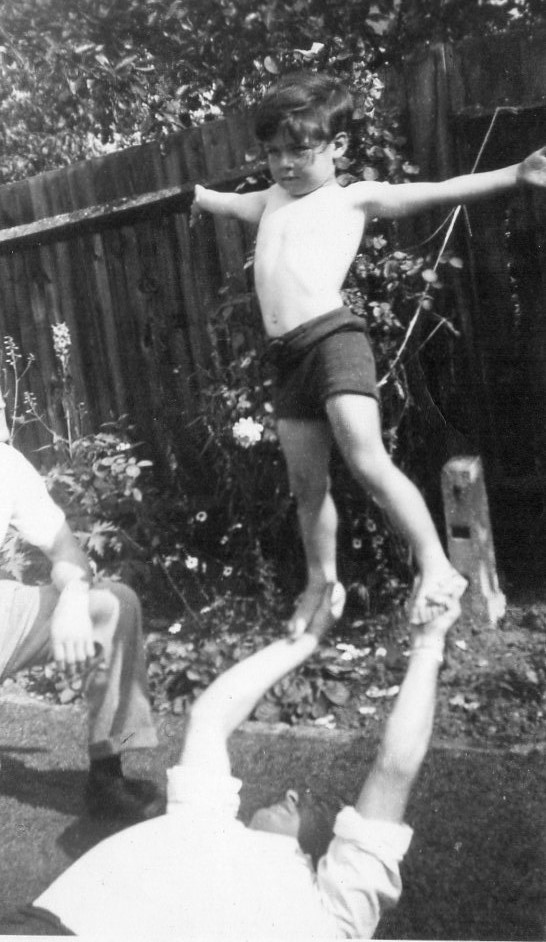
Ron before leaving England - getting in some surfboard riding practice!
We came out on the ship called the Largs Bay. This caught fire while we were in the Mediterranean and we ended up in Aden for around three weeks.
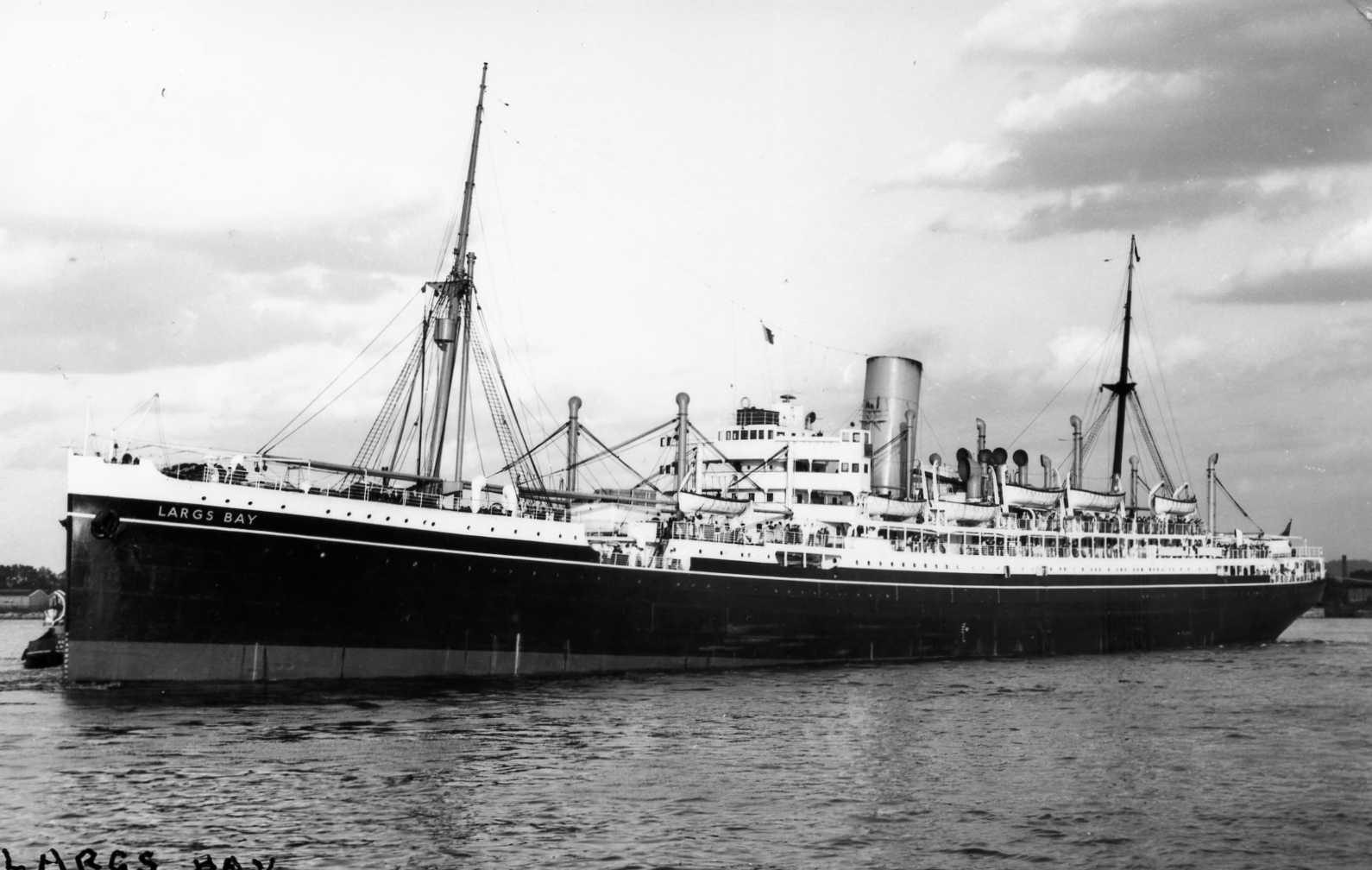
The Largs Bay - launched in 1921, as a mixed passenger/cargo ship. During WW2 she took part in a large number of convoys. She was scrapped in 1957. Her sister ships were Jervis Bay, Moreton Bay, Esperance Bay and Hobsons Bay. She carried many passengers to Australia to start new lives after WWII. One of her last uses was as a film set for some of the interior scenes in the 1958 film "A Night to Remember" about the loss of Titanic.
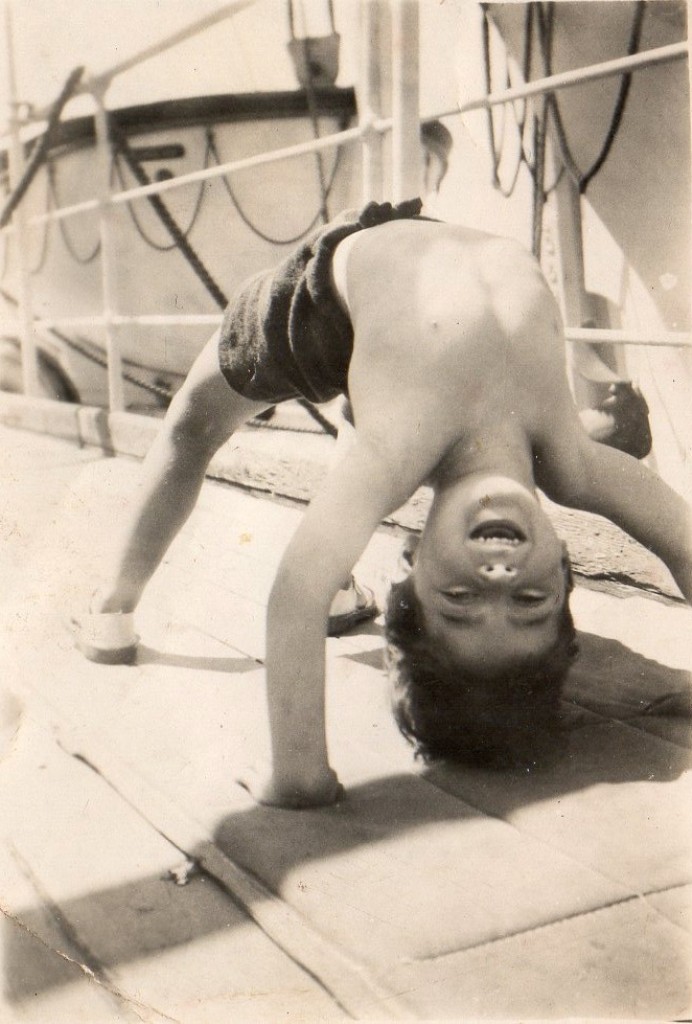
Ron getting some exercise on the way out to Australia on the Largs Bay 1949.
We landed in the Port of Melbourne finally in October, got a train up to Sydney and at first were in Lane Cove for a few months, in the caravan park there on Fuller’s Bridge, then onto a little farm at Castle Hill, which was bush. We then ended up at Newport, in Bardo road, were there for about five minutes with me going to Newport Public school for a few months before he moved to 810 Barrenjoey Road, Careel Bay, Palm Beach, in 1950.
The place was called ‘Goodawada’ and was on the high side of the road just before you climb up the hill to Surf road, we overlooked Stokes Point. The base of the house was sandstone and the rest fibro and wood, tin roof, a water tank, a bit of everything really. Everyone had a water tank then.
Dad was working in the city, would catch the old 190 double-decker bus in, and occasionally our next door neighbour, Scotty Allan, who was one of the founders of QANTAS, and lived there for a few months, and then married to Barbara, would take dad into town on his way to Mascot in his Jag. Dad reckoned being in that Jag with Scotty was more frightening than flying a Beaufighter or Mosquito in the war. He drove it like a bloody jet apparently.
I have a book called ‘Scotty Allan, Australia’s Flying Scotsman’, which is about Scotty, and read in that about his first wife Ailsa being killed during the war at Palm Beach while fulfilling a coast watch. In 1943 Ailsa died in a traffic accident as she returned home from volunteer coast-watching for Japanese warships at Palm Beach. Some sources state she was struck by a bicycle. She died at Palm Beach and was interred at Manly.
ALLAN.-On February 9, at Palm Beach(as the result of an accident), Ailsa, beloved wife of Wing-Commander G. U. Allan, A.F.C., and sister of Mrs. J. F. Chambers, Toorak. Privately cremated. Family Notices. (1943, February 12). The Sydney Morning Herald (NSW : 1842 - 1954), p. 10. Retrieved fromhttp://nla.gov.au/nla.news-article17836678 From: www.pittwateronlinenews.com/george-scotty-allan-history
My memories of Goodawada stem from those years when you do just start to remember things. I recall there were snakes everywhere. Poor old mum, coming from Surrey in England, was freaking out. There were those great big goannas and the place around us was alive with black, brown and grey snakes. There were lots of koalas too.
I attended Avalon Public School when it first opened, there was only a few handfuls of kids that first year. I cherish those days – this was just a wonderful place to start living in Australia in. Ken Mackey lived across the road from us and was my first mate here. He still lives at North Avalon today and I can pick up the phone and talk to him – decades on.
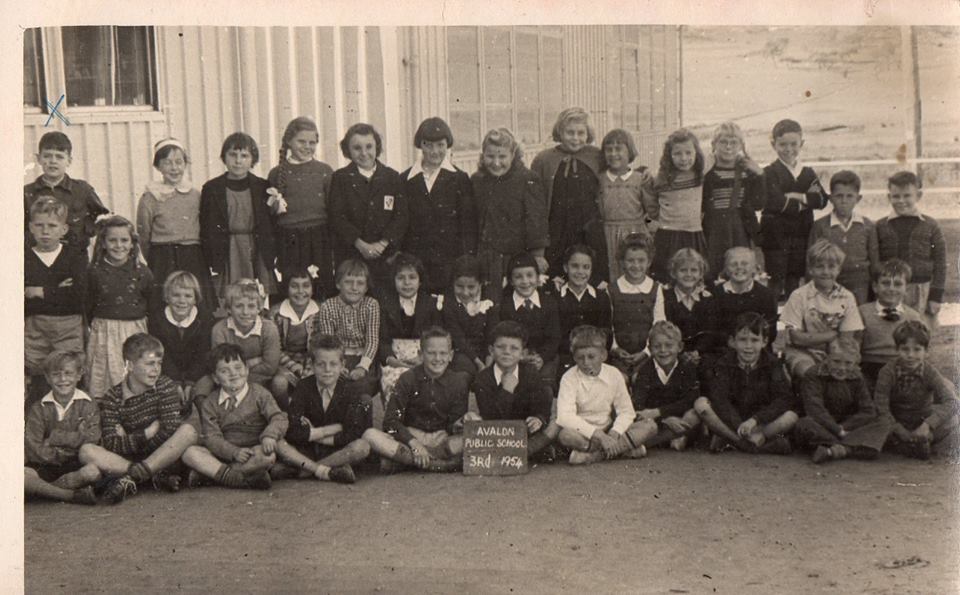
Avalon Beach Public School 3rd Grade, 1954 - Photos courtesy Ron Turton and Geoff Searl, Avalon Beach Historical Society - Geoff has named class members below
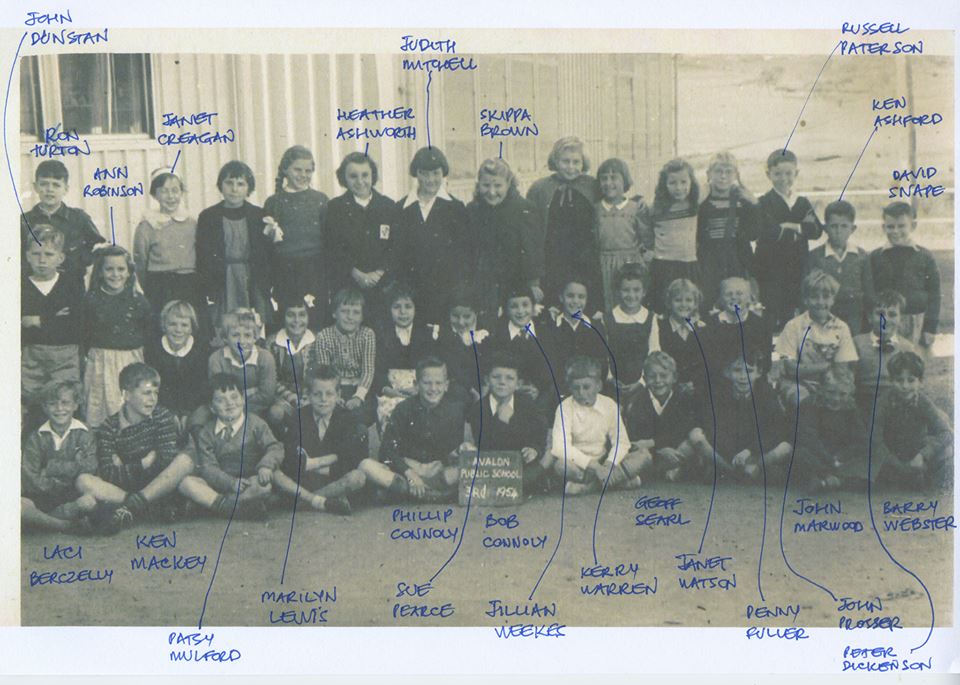
The Gilberts were just down the road form us too, Tommy Gilbert. That was Ces, his dad, they lived on the corner of Currawong Avenue and Barrenjoey Road. I can still picture Ces and his wife and Tommy and Edna still, lovely people. The Anthills, the great Sailmakers, were just across the road and up a bit too.
All the houses had a name in those days. The Mackey’s home’s name was a question mark ‘?’, which made the front page of the Sydney Morning Herald!
What did you boys do for fun then?
We’d get in the mangroves, that was fantastic. Where the dog park is now was all mangroves. We’d walk across the road to Ken’s place, there was a spare block of land we could cut through. Ken’s dad used to make these canoes out of cast iron metal, we’d go right up the mangroves, around the back of Hitchcock Park, you could go for miles, or what seemed like miles to a 7 year old paddling – there was an old barge there that had been stranded and set fire to. It was an adventure to us, prior to it all being filled in. at one stage there was lantana stretching from Central Road right up to almost Palm Beach – it had gone wild.
It was at Careel Bay that I learnt to swim too. Dad was a very strong swimmer, used to swim at the Wembley Baths. Pearl, who is 18 months younger than me was taught to swim there too. My little brother Ross came along then too, he was born here in 1950.
A lot of people may think ‘wow, you lived at Palm Beach’ but really a lot of the people who lived here permanently then were just regular Tom, Dick and Harrys. It was cheap to live there then though – I know friends I still visit there who moved from the Western Suburbs to Palm Beach in 1955 because it was cheap to live there.
There was no sewage, to catch the old 190 into town took hours and there were only a few services each day – it was still the outer suburbs then.
Manly was the place you went if you had to do a big shop.
I remember the postman, who was on a motor bike. When he used to come down the hill from Surf road, Pearly and I would be waiting to grab the mail because we knew he had passionfruit and bananas on him, which he’d give to us. For the milk we’d put a billycan out. I recall one story associated with that. the milk was delivered when it was still dark. The milkman’s name was Bladen and his nicknames was ‘No Change Bladen’ as it was sixpence for the milk and if you left a shilling out well, it just went, you didn’t get the change back.
I remember when the theatre opened in Avalon in 1955; that was huge!
There used to be an old open aired one at Newport, which we didn’t go to much. There was one at Narrabeen too which was called ‘The Flea Pit’, that was up from the ice skating rink. Theatres didn’t have good names then, always something horrible like ‘The Flea Pit’ for obvious reasons.
When Avalon was coming along we didn’t know what they were going to call it – others had been called things like the ‘Odeon’.
One day Ken Mackey came running up to our house and said, ‘Ron, I’ve found out what the new theatre’s going to be called!’
‘Wow, what’s it going to be called?’
He answered, ‘the galah!’
I said, ‘The ‘galah’ ?!, that’s the worst name I could ever think of!’
He said, ‘oh, there’d have to be a reason.’
We used to catch the bus into Avalon, it used to come down into the village then, and then walk up to the school, walking past the theatre on the day of course. The next day we’re doing this and there was this sign; ‘The Gala Opening’!
(laughs)
I still hold him to that and he denies it profusely!! What a galah to say that!
Avalon Beach Cinema; Opening of Avalon Cinema Theatre – Adele Spry's father Arnold Spry built this with partner Larry Quillen. Photos courtesy Geoff Searl, Avalon Beach Historical Society.
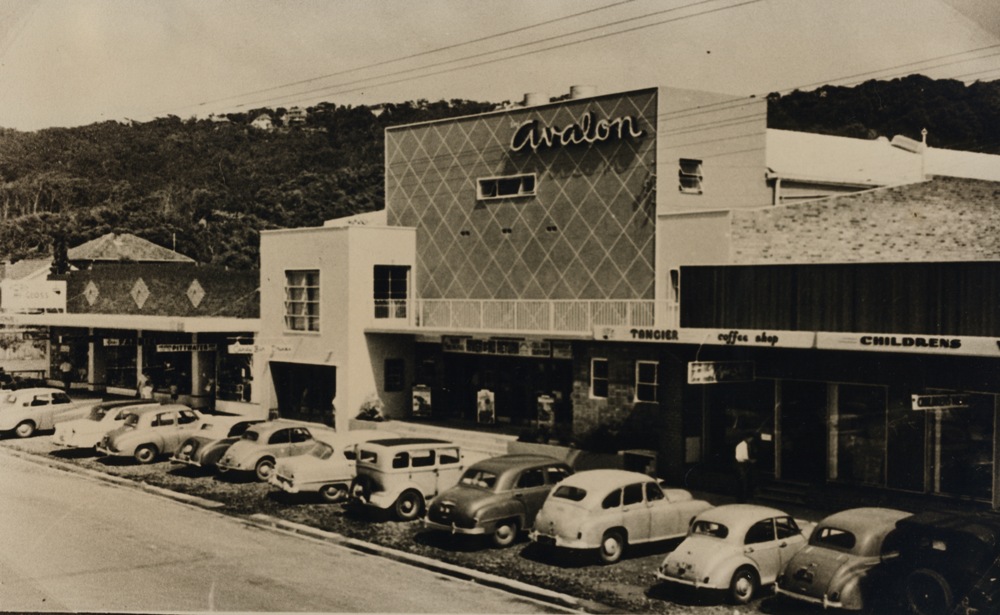
Avalon Cinema Theatre - soon after opening night.courtesy Geoff Searl, Avalon Beach Historical Society.
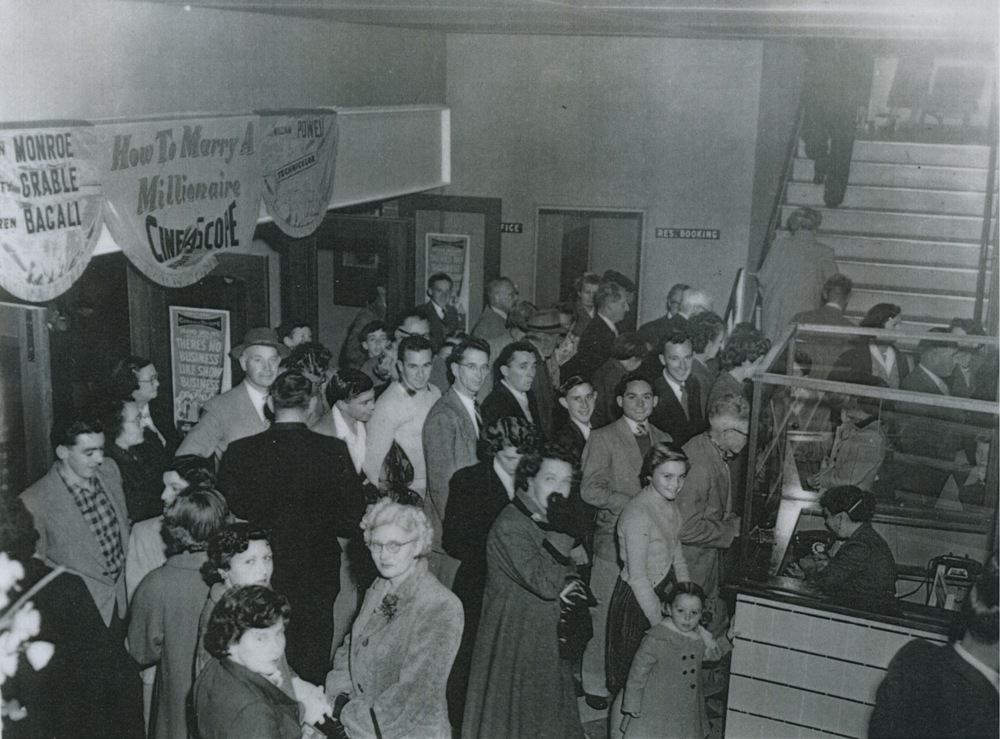
The crowd buying tickets on the opening night - 28 July 1955! Courtesy Geoff Searl, Avalon Beach Historical Society.
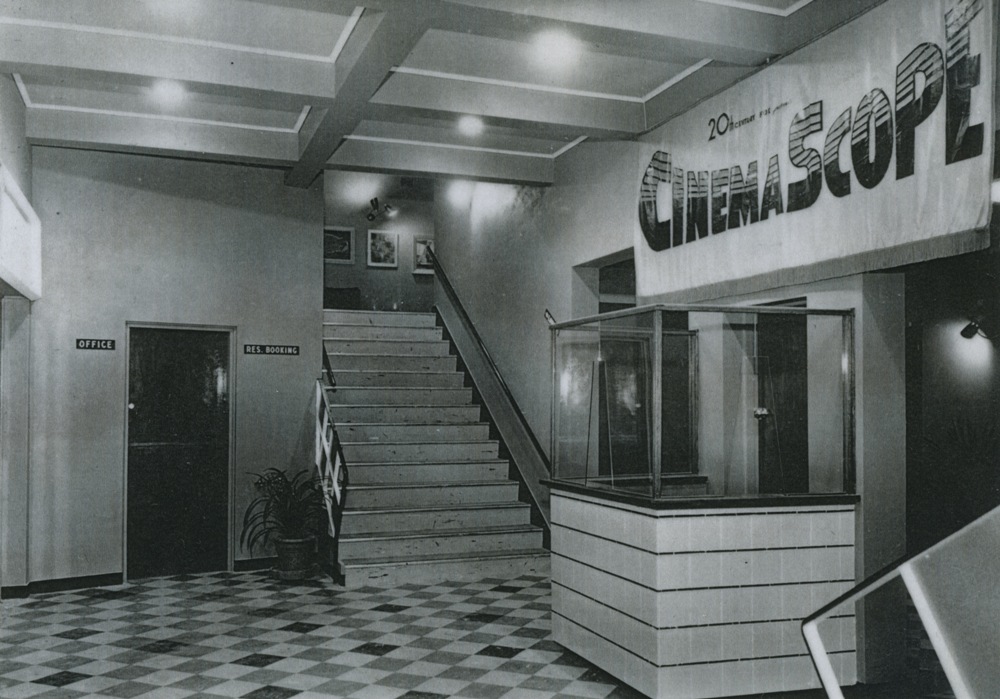
The brand spanking new box office. Courtesy Geoff Searl, Avalon Beach Historical Society.
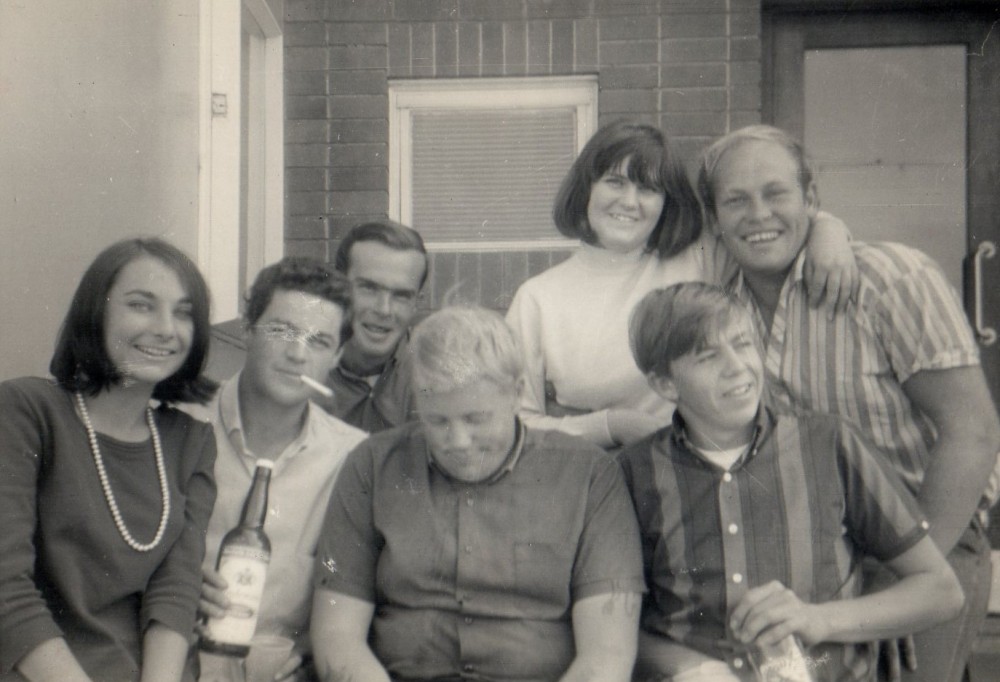
Some Avalon/Palm Beach 1960's locals pictured on a Sunday morning outside The Avalon Theatre. Jill Baker, Ron, David Norton-Smith, John Prosser Ha Ha wake up "Pine" (unknown) Eddie Manning and John Ward. Photo courtesy Ron Turton
When did you first go to the beach?
What happened was dad got a bit tired of going into the city. He was working at a carpet company, and was dong a second job at Luna Park. The poor bugger used to get home at all hours, it was too much.
A mate told him he had a place at Leichhardt, which would only be a tram’s journey to the city and take 10 to 15 minutes. Pearl, Ross, mum, dad and I hopped in a truck and off we went from Goodawada to Leichhardt. What a culture change that was.
We made a lot of friends there and I’ve always recalled to Pearl what a great year we had there; half of 1956 and half of 1957. Word got around the school that this bloke from Palm Beach had landed here – I remember the headmaster calling me into the office and asking ‘what did your father do wrong?’, I said ‘pardon?’ – ‘well, you’ve come from Palm Beach to Leichhardt, no one does that!’
Then all of a sudden the manager of the Palm Beach Golf Club, whose name was Ron Gassman, who was a friend of dads’, contacted him; ‘I can offer you a job at the Palm Beach Golf Club and it comes with a cottage out the back. You will be back to where you really belong mate’. This was towards the end of 1957.
So back we went. What a place to live, overlooking Lion Island, so close to the beach.
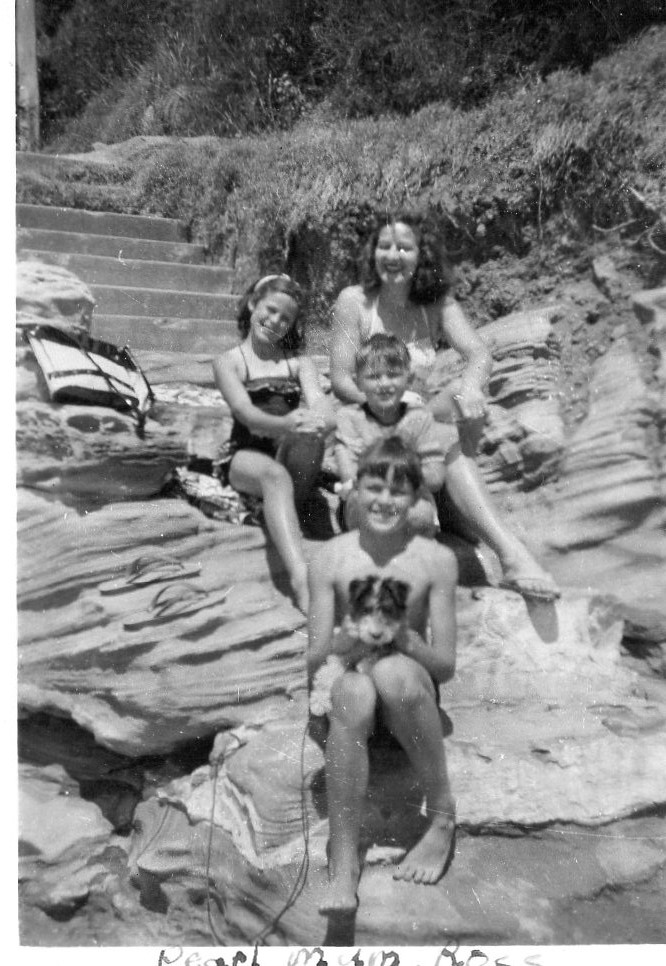
Turton family 1957 at Palm Beach Pool; Pearl snr., Pearl, Ross and Ron Jnr.
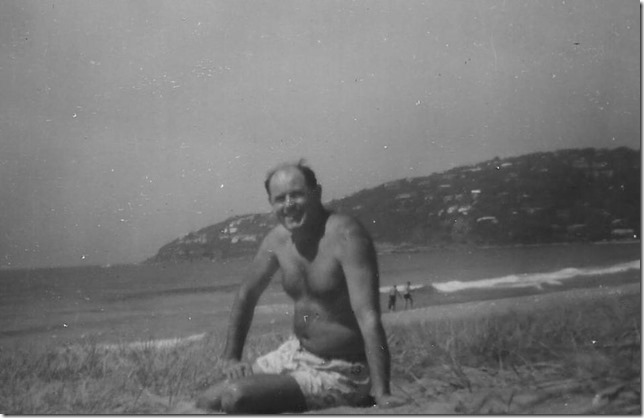
Mr. Ron Turton Snr. on Palm Beach, March 20, 1961
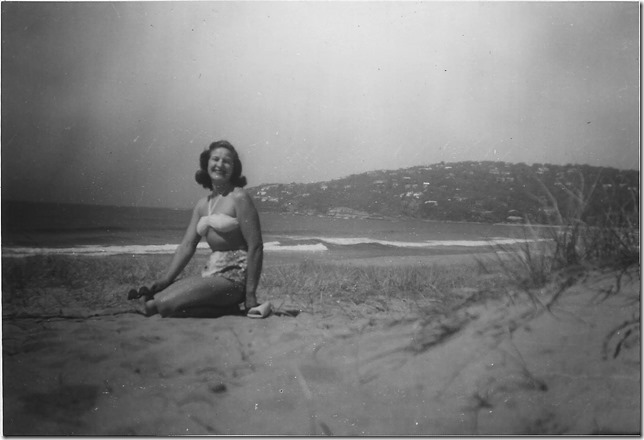
Ron's Mum Pearl Turton taking in the sun at Palmy March 20, 1961.
That is when our real interest in surfing started. We’d just walk around the corner to the beach. Pearly and I just took to the water, with our surf’o’planes.
Eventually someone lent me a board, someone from the surf club it was. It was a Malibu but there were a lot of the 16 footers around then too. Everyone at Palm Beach then would say Hi, Hello, How are you – it was that kind of place. I knew John Prosser, and Richard Parkinson came along later.
At Palm Beach then surfing was everything, it was IT.
Because during the week no one was there, Pearl and I would have the run of the surf. When we went to High School, I went to Manly in 1958 because Narrabeen hadn’t been built. In 1959 I moved to Narrabeen as you had to go there if you lived between Collaroy Plateau and Palmy. By de-facto I was Narrabeen Boys High first School Captain. I was good at sports, loved running and won the hurdles and the hop-step and jump. I was voted class captain, I was in 2a. We didn’t have an official school captain until that first lot of Leaving Certificates, but in the meantime we needed a school captain to liaise with Narrabeen Girls, which was next door. Graham Griffith was vice-captain, he was from Mona Vale and he was in 2b.
One of my duties was I had to plant a tree out the front of this brand new school. Well it died – that was a good start! Graham’s grew for some reason. It was all good fun but it was a bit hard because it didn’t have any history yet, it didn’t have any culture. Manly, even though it wasn’t a really old school like Sydney high or Kings, they were a very good scholastic and sporting school; they had state swimming champions and state running champions; if you got in a team there then you just won.
Here we were at Narrabeen in its first year in these terrible old demountable classrooms and old fuddy duddy teachers, many of whom seemed to be just counting down to when they retired or a lot of them pretty well straight out of Teachers College. So when we started winning a few things I think that made the school, we became a school through that. I remember that first year, 1959, I won the goalpost to goalpost full sprint on Brooky oval. I remember being presented with the pennant on the Monday when they had the assembly and it was ‘hey, who is this new school’.
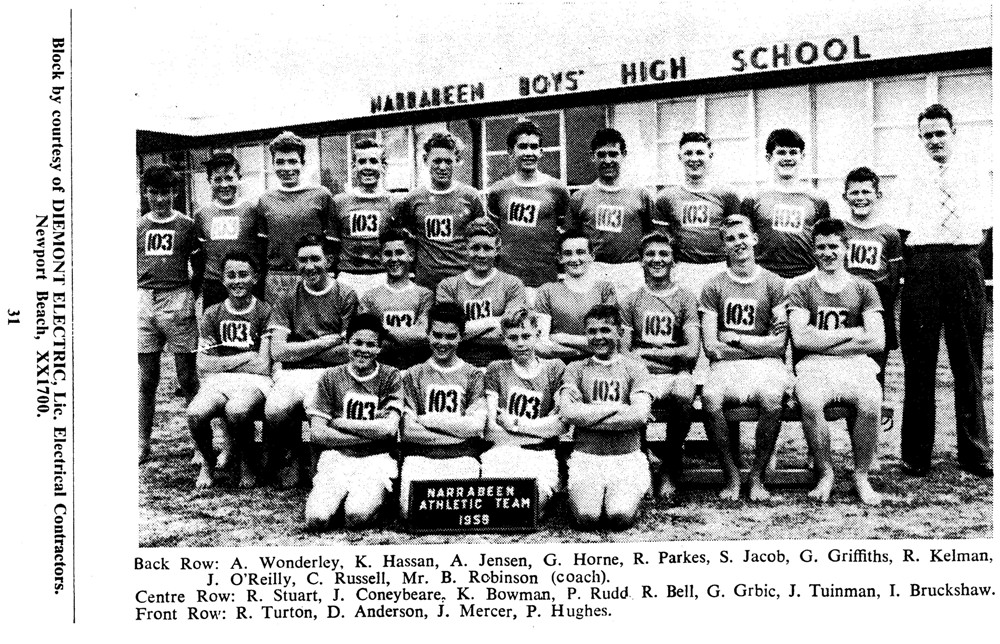
1959 Athletics Team NBHS
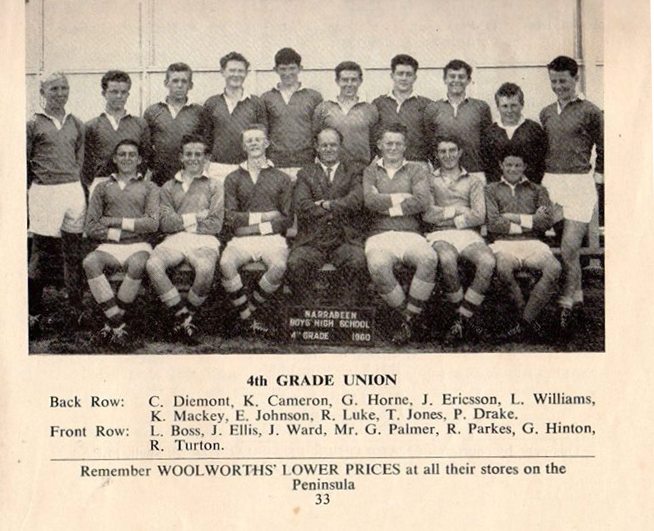
1959 4th Grade RU NBHS
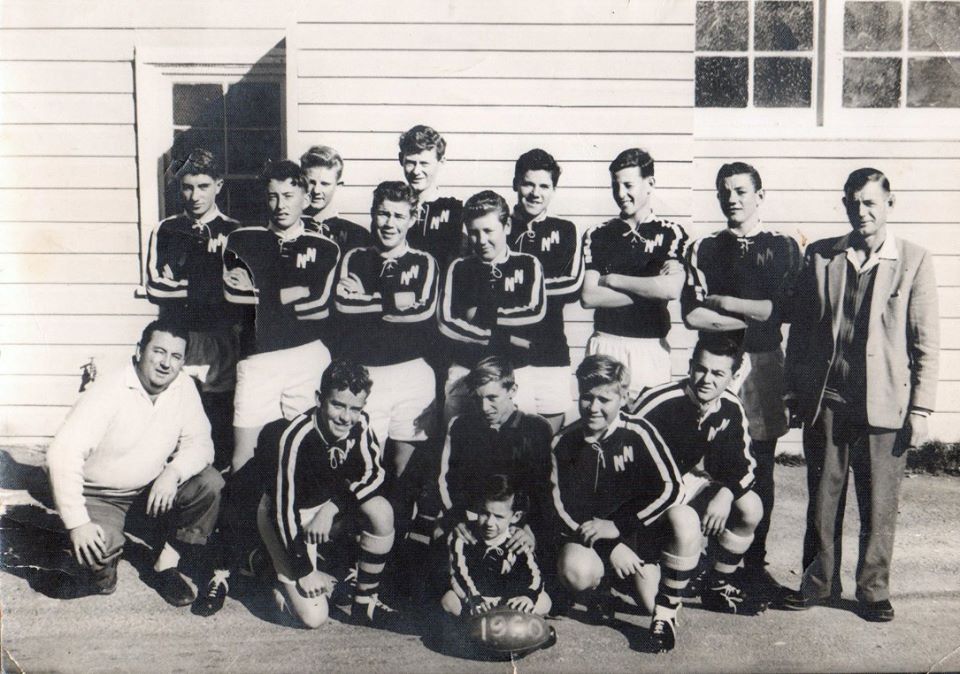
Narrabeen Football Club 1960: U 15's. Coach - Jim Pounder; Manager - Jack Kinninment. Jim Pounder and Jack Kinninment are both Life Members as is Garry’s father, Keith Crompton. From top left: Graham Hinton; Bob Stuart; John Ward; Doug Chilvers..; John Ericsson; Terry Jones..; Ron Turton; Paul Drake; Norm and his Dad; Front: Jack Kinninment, John Ellis; Graham McIntosh; Garry Crompton, Yubo Krilich
This photo was taken at Brookvale Oval. Photo courtesy Garry Crompton
At any rate, from then on the surf became our life. With Johnny Prosser and Ken Mackey, Laci Berczelley, Johnny McIlroy, they were from North Avalon, Ken was still at Careel Bay, we’d all just go to the beach, it became a culture for us. It turned out I was a goofy footer. When we were on the bus back, and we knew which way the winds were blowing, they’d all stay on the bus out to Palmy and have a surf.
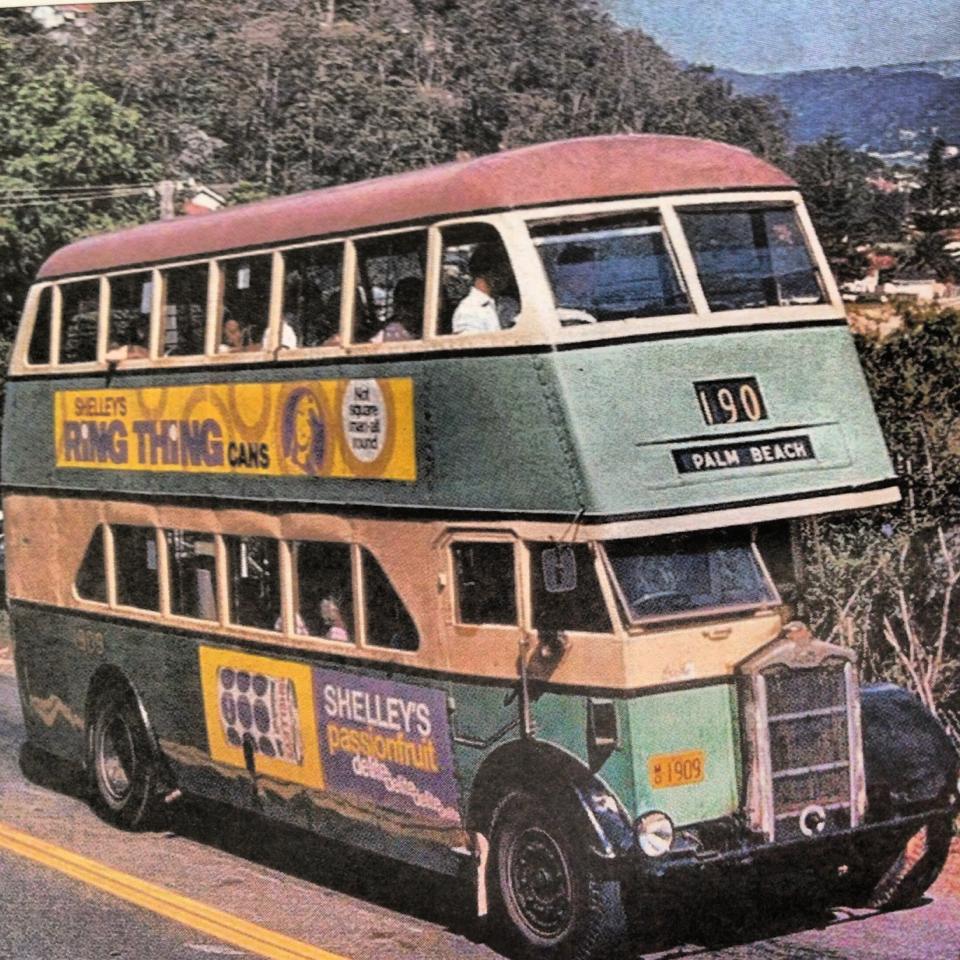
One of the earlier 190 (pre L90) buses climbing the hill between Palm Beach ferry wharf and Observation Point, Palm Beach.
This is getting towards the time when the Beachcombers started.
This began when Johnny Hawke’s Beach Buffet was on the southern part of the dressing sheds. Upstairs was where the food was sold; pies and hot dogs, that sort of stuff. What he sold the most of was that Golden Circle Pineapple juice. He was onto a great thing there; people used to visit Palm Beach in the thousands on the weekends.
There was Howlett’s store where the bus terminates and then John Dunne’s, who had the Cock and Bull, came along later. That was next to Howlett’s.
Johnny Hawke used to sell a pie for 1 and sixpence; the profit he must have made would have been enormous. The juice sold like hotcakes.
Downstairs they’d originally tried to sell souvenirs but it just didn’t work. He said to us one day, ‘look, we’ve got this spot downstairs, you guys can have it.’ – to use to put our boards in. I used to carry mine back to the Golf Club and they were bloody heavy then.
My first board was a balsa board, and then the foam board revolution came in. I remember working at Johnny Hawke’s and saving up all this money for a board – he used to give me one pound a day, which was a fair bit but I would work from six in the morning until six at night. Dad held that old principle where if you wanted something you earned it and saved your money up to buy it.
So I’d be there working my guts out serving hundreds and hundreds of people while all my mates were surfing. And of course that view from where we served looked right down the beach from over the dressing sheds.
This became the place where the gang gathered. For my first board I’d wanted a Scott Dillon board and had saved up £28 and knew the type I was getting. Dad said, along with a mate of his, that I was wasting my money. I remember dad bringing this board in, to which I said, ‘dad, that board is a joke, I don’t want that’.
Dad said he’d already paid for it, it’s £12 – so I was pretty annoyed, I wanted a Scott Dillon board, they were the go. At any rate I ended up with this Beale as my first board, which was a balsa board and it just didn’t suit me – I was the laughing stock of the beach. It was really heavy at the back, the nose was that paper thin I thought it would snap off. My fears were realised when it did.
At any rate, this nice little piece of real estate was given to our gang to use in 1959. We’d keep our boards there. Prior to that, if we didn’t take them home, we’d leave them behind the Palladium. No one knocked them off.
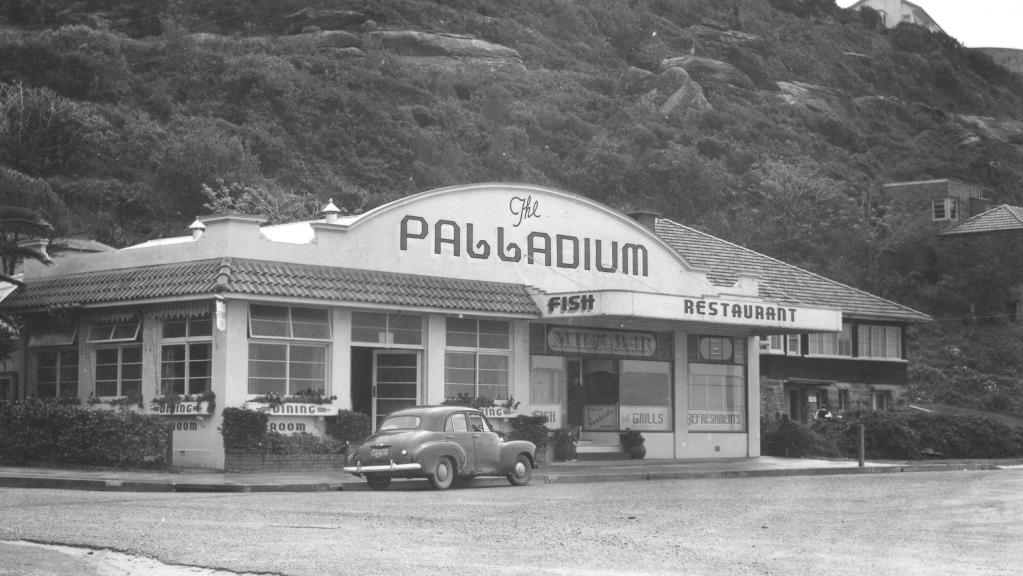
The Palladium circa 1950
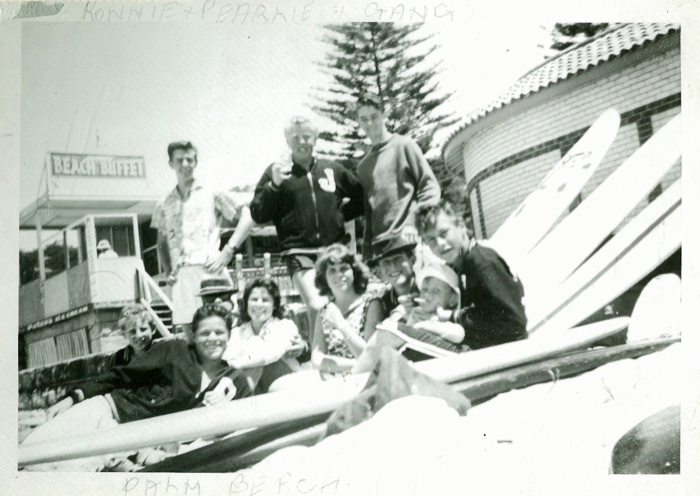
Some original Beachcombers Surfboard Riders Club Palm Beach NSW 1961 near the present day dressing sheds. Note Johnny Hawkes Beach Buffet in the background washed away in king tides. The Beachcomber’s Club was underneath the Beach Buffet. Back row – Ken ‘The Blue Streak’ Mackey, John ‘Pine’ Prosser, Richard Parkinson.
Front – John ‘Olly’ Oliver, Ron Turton, Johnny McIlroy (with hat on)Pearl Turton, Glenys Pearson, John ‘Beaver’ Gonsalves, Ronnie Berczelley (smoking!)and Laci ‘Hompus Stompus’ Berczelley. Note the jackets with the initials on them. ‘Cooky’ Burnes style from 77 Sunset Strip! photo- Ron Turton.
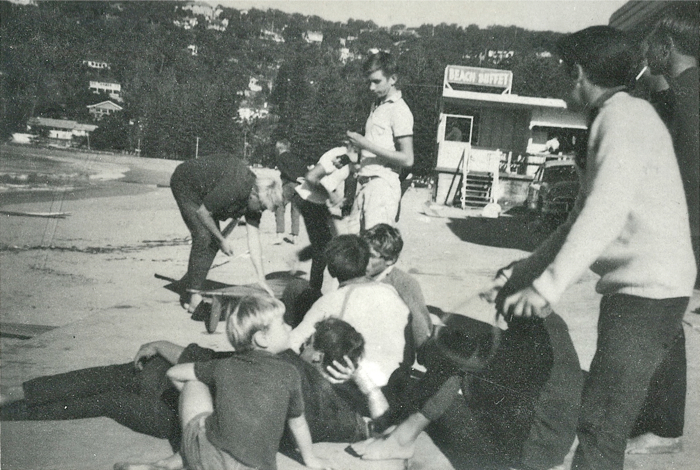
Standing: John ‘Pine’ Prosser waxing board, Rodney ‘Rouge’ Harris
Sitting – Steve Campbell (blond child) Leigh Campbell (with hand on head) Lee ‘Bombie’ Beacham (white jacket), Alan Ward (guy talking to), Rodney Campbell (white jumper) and Laci ‘Hompus Stompus’ Berczelly (smoking).
The gentleman in background looking like he’s doing The Stomp is Tony Bradley.
Check out Col Brown’s famous Ford Twin Single Spinner it went on many a surfing safari. Picture taken at Palm Beach dressing sheds. South Palm Beach in the background the washed away Beach Buffet and Beachcomber’s club. Photo - Ron Turton.
What a spot, looking straight out over the ocean. The name of this place became ‘The Beachcombers’ but I was a club in name only. We didn’t register it, we didn’t take membership, no minutes or anything like that.
Our claim to fame was though that we were the first surfboard riding club in Australia, until proven otherwise. If you look at the Surfing Australia: a Complete History of Surfboard Riding in Australia (2012), that Phil Jarratt put together, he sort of acknowledges that. There were these others from South Bondi who put forward a similar claim but I ask you – where was South Bondi ?!– here we were in this little part of Australia called ‘Palm Beach’!
We were the centre of the universe! Nothing else existed!
We never copied anyone – anything we did down there was from our own skills and thoughts. It was decided we’d call this club ‘the Beachcombers Surfboard Riding Club’ and a photo was taken, which I’ve sent to you, which has been in every single book about the peninsula; half of them haven’t even got captions under it. I still have the negative of this.
Who took the photo?
We think it was Alex McTaggart and we think this because he wasn’t in it. We know he was there - his brother is in the photo.
There has been a lot of argument as to who took it. One day Pearl and I were going through these old surfing magazines we had and in an envelope among these we found the negative.
Alex says he only knew a few people in the photo – his brother, Johnny Oliver and Frank Gonsalves, but I’m pretty sure it’s him that took it.
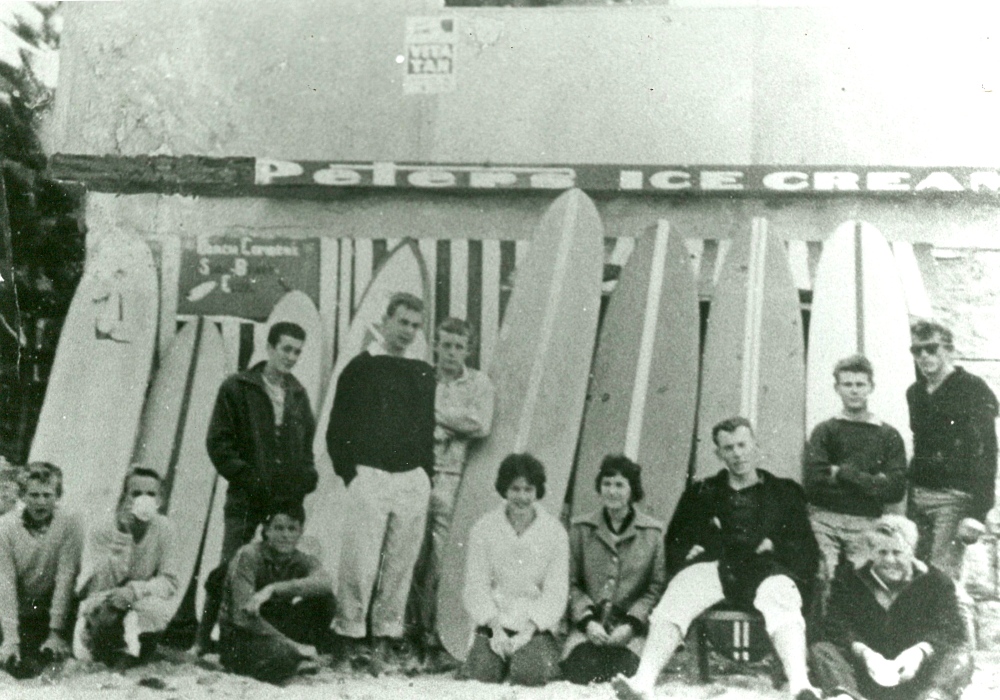
The first Australian surf board riding club – the ‘Beachcombers Surfboard Riding Club’ of Palm Beach NSW and their boards 1959.
Seated (left to right) – John ‘Olly’ Oliver, John ‘Johnny Mac’ McIlroy(drinking soup), Ron Turton, Neridah Wright, Joy Gassman, Billy McTaggart, John ‘Pine Apple’ Prosser.
Back (left to right) unknown, John Pullenger, John Dunn, Peter Dever, Frank ‘Speedy’ Gonsalves. (photo Ron Turton).
The most interesting part about all that is, and there were two generations together in there; the older blokes who were around two years older than I, and I tell you when you’re 14 someone who is 16 seems really mature, us younger ones, Johnny McIlroy, Johnny Prosser, Laci Berczelley and me decided we should have a jacket.
What you have to remember about those days is there was all this guff about the surfers and the rockers and how we were trouble – the clubbies and the surfers did not get on. There were a lot of problems there for a few years; the Surfers and the Rockers and the Widgies and Bodgies, there was this thing about Surfers being layabouts and we all smoked these foreign cigarettes – that was another thing.
These jackets were unbelievable – they were black and had white seams in plastic down the side and on the back was ‘Beachcombers, Palm Beach’.
There was a show called ‘77 Sunset Strip’ and a bloke called Cookie Burns who was always combing his hair backwards in a real Elvis Presley style. In the Archie comics all the blokes had their initials, like in the college style.
We decided we’d have that too – I had a big R on the front, Ken Mackey had a big K – we were so cool!
We were half Surfer half Rocker – we loved all the Everly brothers music, Johnny O’Keefe etc., but we also loved surfing.
We ordered about a dozen of these jackets and we thought we were so, just, ‘cool man’. We couldn’t wait to wear them – we’d wear them down to Avalon and strut around – when I think back we must have looked like West Side Story, only of Palm Beach!
I’ll tell you one story that helped put Palmy on the map. One year when still at high school, 1960 this was, they used to have this big rugby league knock-out comp. It started at Keirle Park and all the finalists got to play at Brookvale oval, which was like playing at the Sydney Cricket Ground to us, that was like ‘wow!’.
One year the Narrabeen Boys High won the whole 8 stone knockout division and had to go to Brookvale. I was 7 and a half stone and thus a bit light for the 8 stone mob, but I was a winger and always the best runner in my age division at school. I remember when they had the mini-Olympics at Avalon I was stuck at Leichhardt; I was annoyed – I would have won the gold in the sprint races. I remember when I got back Mr. Archibald lined me up against those who had been the sprinting gold medallists and I had to look around when running the 100 to see where they were! That’s fair dinkum!
Anyway, that wasn’t meant to be.
In high school I remember I had to lose all this weight to get to 7 stone because Mr. Russo, who didn’t like me much, told me to go and play with the 7 stone team. I remember I ate a Sao biscuit and a cup of tea every day for a week, nearly killed me. I got down to 7 stone quick smart.
The 8 stone team won it and got through to the State finals and had to go into the big time, into town and the Sports Ground - the Sydney Cricket Ground was next door. I was thrown in as a Reserve because I’d won the 100 yard sprint in full footy gear at Brookvale Oval at the district knockout comp. So for those two weeks leading in I ate like a horse and ended up at 8 stone. Laci Berczelley was in that team, as was Johnny McIlroy.
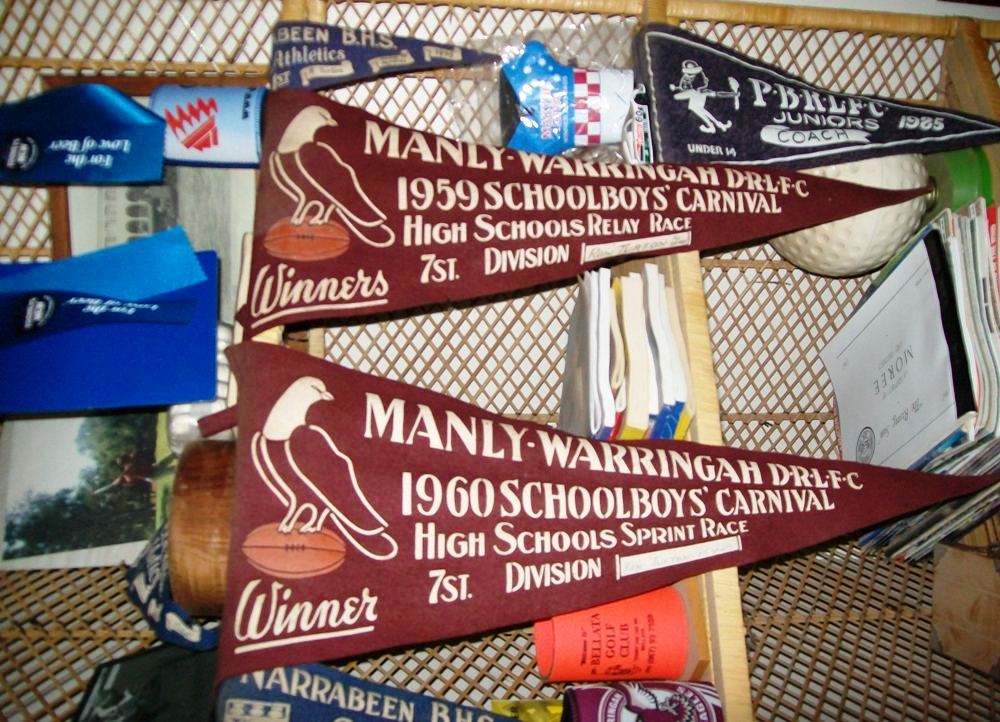
Ron won these Manly Warringah Rugby League High School Carnival pennants while attending NBHS in the school's first two years 1959 and 1960.
We wore our Beachcomber jackets into Sydney. We wore these jackets walking from where you get off the bus, up George street, up Martin Place to Elizabeth street and then got the bus into the showground. There were all these people in from Nyngan and Tamworth for the State titles and these three dudes walking through the crowd with ‘Beachcombers, Palm Beach’ on their backs.
Did you ever run into Midget Farrelly while at Palm Beach?
Oh yeah. Bev and Pearl were friends, still are. When I was at High School, Beverlie’s father, Jack Carter was the Secretary Manager at Avalon Beach RSL. I knew Bev too, everyone knew each other.
I first met Midget unofficially while surfing. That cheeky little bugger Nat Young was around too. I got to know Midget well, as everyone did. I remember one rainy night when dad was still working at the Golf Club there was a bang, bang, bang on the door. I opened it and there was Midget in some yellow oilskin North Sea Fishermen outfit and his motor scooter. He came in ‘G’day Ron, Ross’ – we’d seen each other down the beach and all the surfers knew each other. We may have been a bit isolated at Palm Beach but we all knew each other were around – the North Av. Group, there were some at North Narrabeen and Dee Why, bloody good surfers too – North Avalon had Rodney ‘Gopher’ Sumpter and Michael ‘Little Dooley’ Mabbit, they were just superstars.
At any rate, Midget had come to see Pearl. Pearl was a great surfer too, she went on to win the Interstate Surfboard Riding Championships in 1963 at North Avalon, which was the forerunner to the Australian Championships.
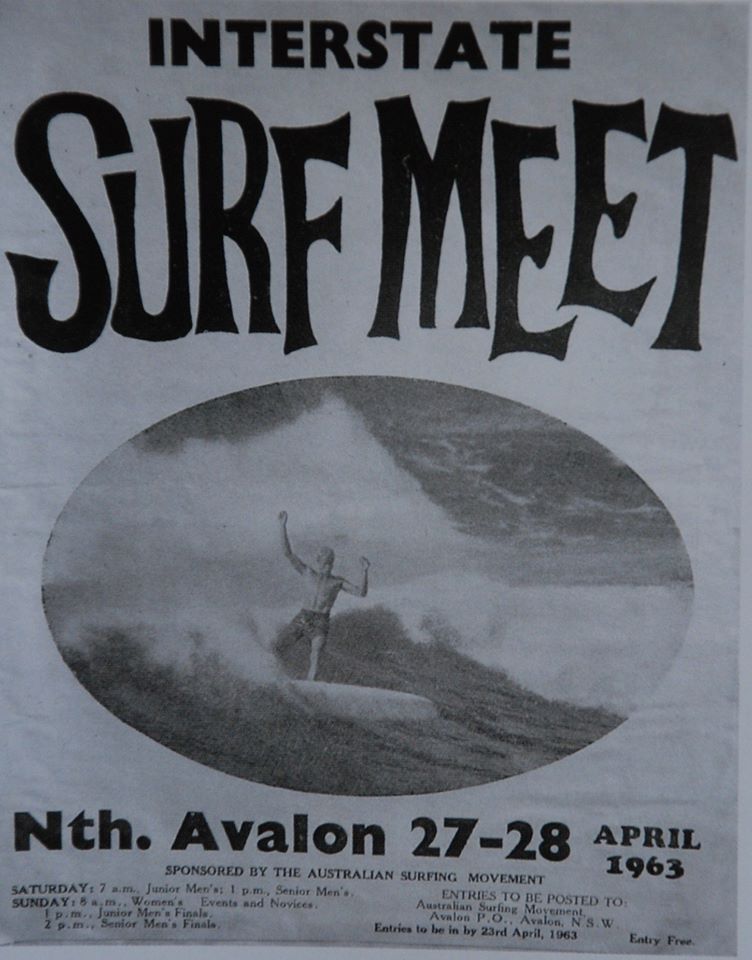
April, 1963 Interstate Surfboard Riding Championships The three Turton children Pearl ( Womens) , Ross (Juniors) and I (men's) surfed in this.
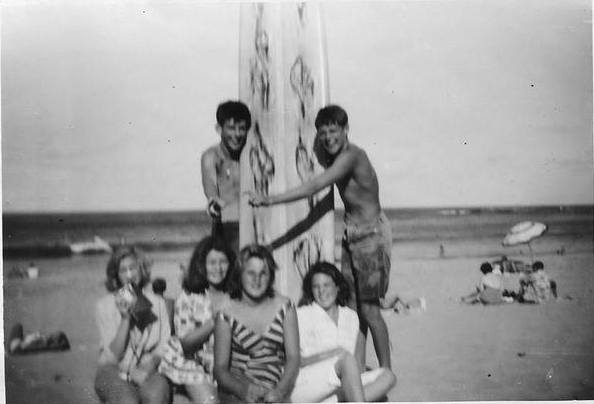
Avalon Beach when we were teenagers. Wayne Reed, Ron Turton, (Front Left to right) Patsy Lane, Sandra Painter, Bridget Berczelley, Pearl Turton.
Ross and I baled him up; I was still pretty young then, still in my teens, - ‘what’s it like to do this?’ – surfing stuff. He was like a god to all of us, and this was years before he won the World Championship.
He put up with us for a while and then, ‘any chance of seeing Pearl?’
He was a good fellow; the respect he paid my mum and dad, he was just so polite.
Midget was basically a shy person then – you had Nat who was out there selling himself. You’d see Midget out there surfing on his own whereas Nat would be right in the thick of things.
I think Midget got annoyed with all the inaccuracies in stories run about him. I recall phoning him about three years before he passed to speak about the wedge fin, which he invented, and had been credited to someone else. He was fed up with it then, had been for years, mostly because these inaccuracies are recorded as truth and what really happens then gets lost. He had a thing about getting it right but had a sort of ‘the horse has bolted’ attitude when one after another story would come out, and they were still publishing stuff right up until him passing.
I remember in 2015 a Farrelly board was found up in the bush on a farm in rural New South Wales and I sent a picture to him asking him what year – ‘’69, an original’ was the answer, straight away. He knew his stuff and he was articulate.
So Pearl was a champion?
She was the Australian Champion in 1963. Pearl was an all-round gymnast; she could run, she could do back flips, anything. I lent her my board one day and she just got up and rode it. I’ve written a story on Pearl – why don’t you run that?
We will! What were the most memorable surfs or swells you remember while The Beachcombers Surfboard Riding Club was going?
There was one I remember that came in outside the Palm Beach Dressing Sheds in 1961 – it was a freak, ran for about an hour, this massive onshore break, and it was steep, about 12 foot. I’ve never seen since or before then. It just came out of the blue. Word got around pretty quickly, but we were there and everyone else came down – Midget even surfed with us, he wasn’t going to miss that wave. I was a goofy and it was a left-hand break and I saw this wave coming in, thought, ‘this is the wave of the day’ and got it, and bloody Gopher was paddling out and went to turn around and I said, well, you know; ‘go away, please’. I got it and turned around to go for it and then just heard this grunt, and out of the bloody tube came Midget – I didn’t even see him; I’d dropped in, but jeez, I dropped out very quickly!
In that last edition of Surfing World, they’ve got ‘Brushes with Midget’ and that wave with him on it is in it. They rang me up and asked me to send some stuff in.
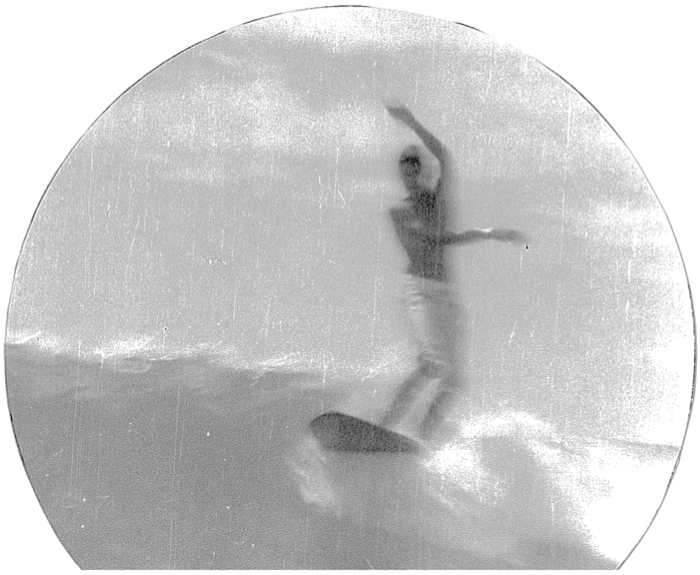
Ron Turton Palm Beach NSW Winter 1959. One of the guys had an underwater camera and used to take pictures of marine life. I was on this wave near the dressing sheds and up he popped in front of me and took this fuzzy photo! Evasive action required on this 9 footer!
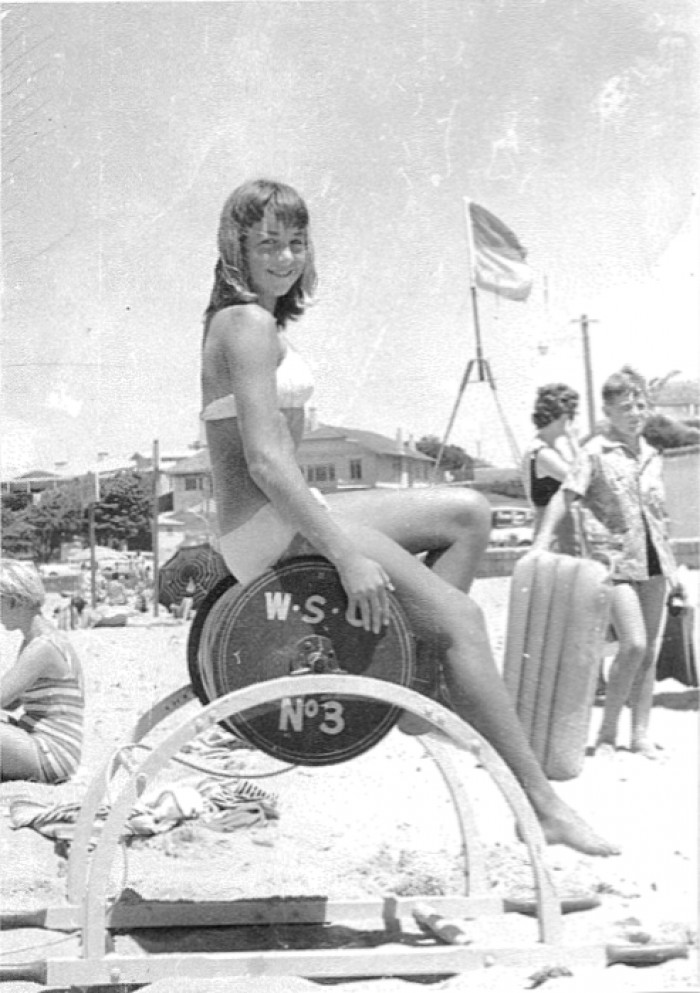
Leone Power of Collaroy Beach NSW a great fan of the surf. Leone was Ron’s first girlfriend and became a sculptress in London. The surf reel stems from the times when Warringah Shore Council (W.S.C.) would issue these to each beach they were responsible for.
Which was your favourite board?
A Scott Dillon, a 9foot Mal. I got him to make the blank and got it back to my mate Richard Parkinson who also lived at Palm Beach with his parents. We glazed it, fibre glassed it and sanded it all back and made it real lightweight by only putting two layers of fibreglass on it. I designed my own fin – was always experimenting.
So 1961 at Palm Beach – what’s happening?
A big change began to happen. We were such a tight group – we’d all been to primary school, then high school. I started working in January 1962, at the Bank of NSW branch at Avalon Beach. They were selling ice-creams and drink when I was there recently. I loved working at the bank but the money wasn’t real good. I wanted to get into Accountancy but out at Avalon and Palm Beach there were no accountancy firms.
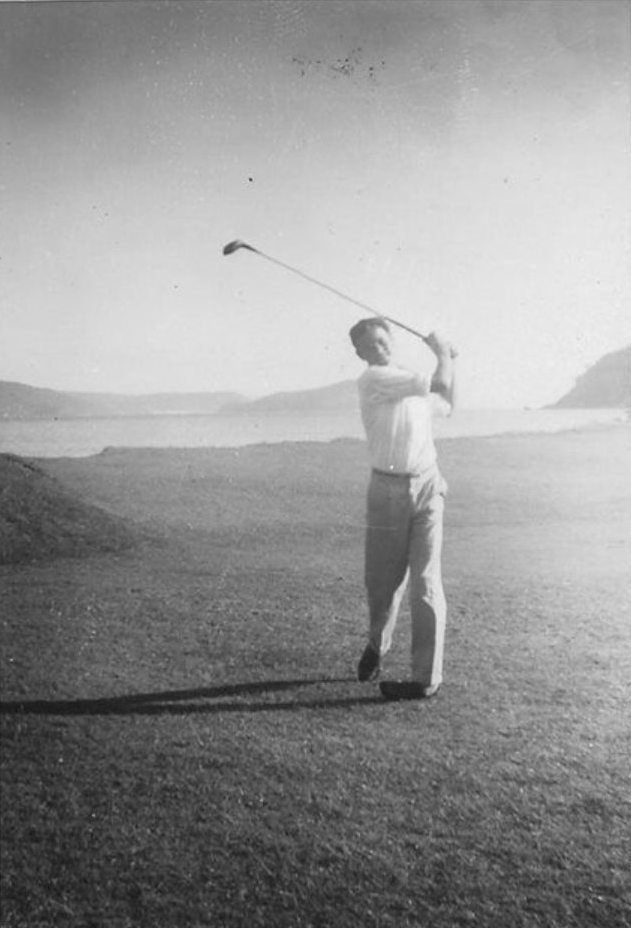
Ron at Palm Beach Golf Course 1961- with a million dollar back drop.
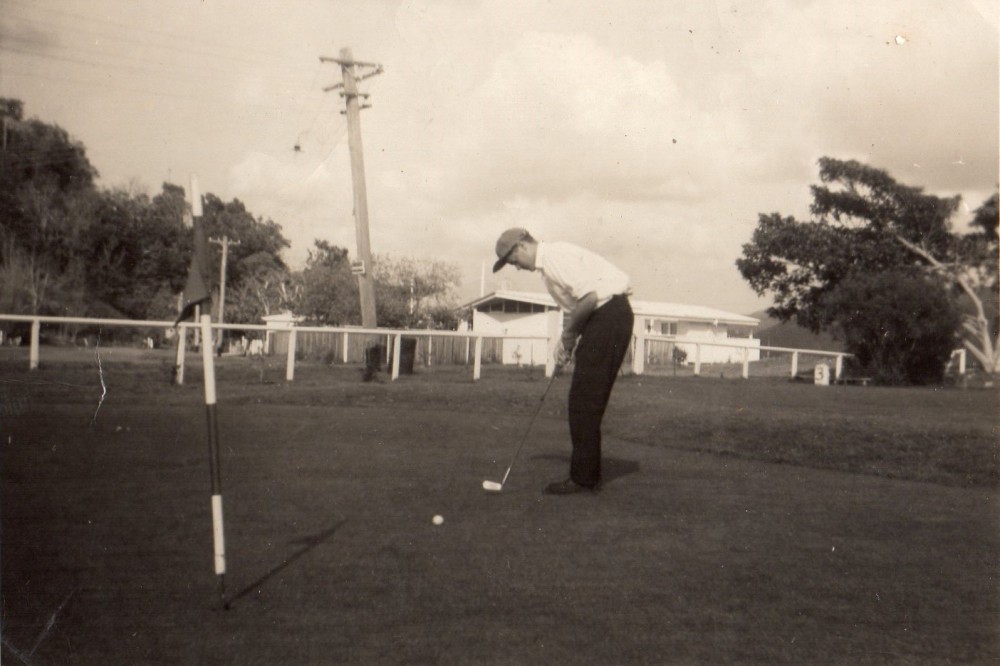
Ron a quick nine holes before work Palm Beach 1962 - the end of Waratah street in the background.
I had a great love of speedway racing, the motorbikes. These used to run in the old Sydney showground. I decided I was going to be the World Champion. I bought a speedway bike called a ‘JAP’, they weren’t Japanese, that was the brand name. I wasn’t game to take it home and so took it up to Jeff Page’s house and hid it there.
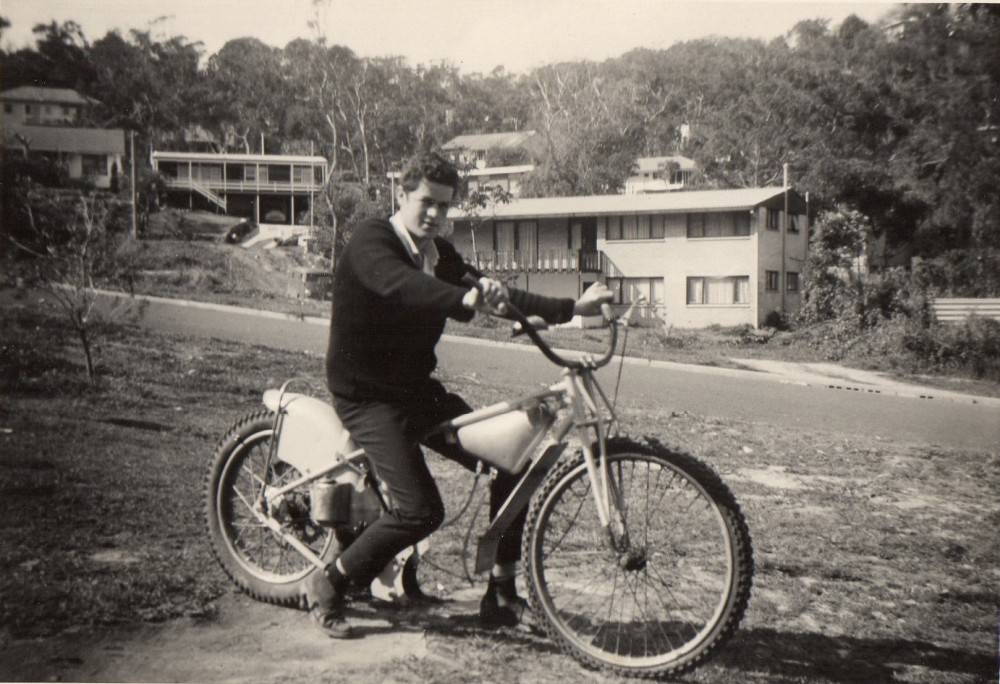
Ron's Speedway bike waiting for a new JAP engine from England 1963. That's Dolphin Crescent, North Avalon/Whale Beach in the background.
Around then I looked at a job at the Water Board, where you would get around £35 a week. I was on £6 a week at the bank. I thought if I was going to get a bike and go to England and learn to ride properly, I had an uncle who was tied up with speedway there as a mechanic, and who knew all the champion rider, as that was where the action was then, I’d need to make more money. I had the frame and bits and pieces and still had to raise the fare – no one flew then, everyone went by ship.
I got home one day and told dad I’d just left the bank, he nearly had a heart attack; ‘I’m going to go to England’.
I got a job on the Water Board and saved up a fortune in 18 months working on the end of a jackhammer. I was that focused, I was going to England. You get a lot of time to think while you’re on a jackhammer, I had it all worked out.
I was still surfing though, loved it.
I booked my fare on the Fairsky, John Prosser was going to come, as was Peter Mobbs – the Mobbs had the fish shop at Palm Beach then.
About three weeks prior to the ship sailing I’d had enough of working and needed a bit of a break. I said to Prosser, ‘listen mate, I’m going up to the Gold Coast to spend three weeks in the sun and then I’m off; this is going to be a big deal, make or break.’
We got up there, we used to surf at Snapper and Rainbow Bay, Kirra, those places, and then we’d go to the Cabbage Patch and Beer Garden- we were having a ball.
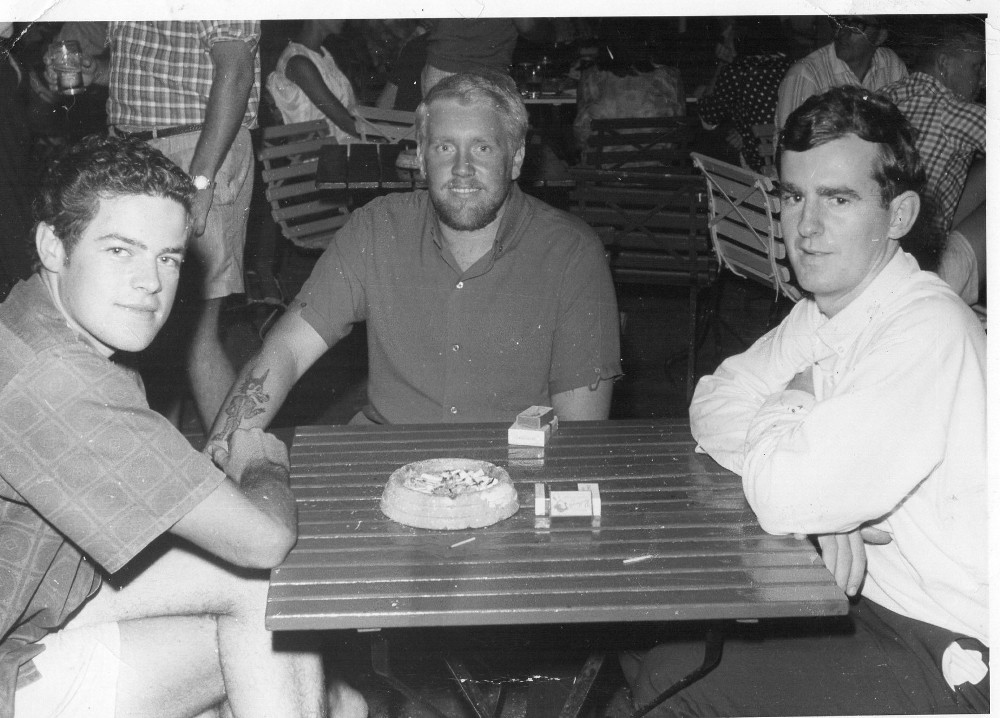
Representing Palm Beach at The Cabbage Patch Beer Garden, Coolangatta Qld. (1963) Ron, John Prosser and Peter Mobbs.
One night one of them said, ‘listen, I’m not going to England’.
Something else shifted up there. I knew the dangers of speedway racing, knew there were fatalities, people ending up in wheelchairs. It was a dangerous sport. I was so confident that I had the balance, wasn’t afraid of speed, had studied every angle ; I’d go into the pits and talk to the riders – I was really into it. my uncle was sending over the magazines form England, ‘Speedway Star’ – I knew all the names, knew all the tracks.
But that little time up at Coolangatta I suddenly started seeing the other side of life; sitting back in the beer garden, looking at the pretty girls and experiencing such a healthy lifestyle. I’m not sure what it was but my focus shifted, I started to have a little bit of self-doubt. I thought it would be great if I became world champion but what if I came off and ended up in a wheelchair. I thought this was a pretty good life, surfing, drinking beer, chasing girls. I stayed another day and another day and then another week and ended up cancelling the ship booking.
I could have been the world champion, I could have been killed on the first corner; we’ll never know.
So it was back to Palmy – by this time mum and dad had moved to North Avalon, right opposite Hitchcock park on the corner of Whale Beach road. It was time to go back to work. Dad bought a baker’s run and had I did that for a while. Then a job came up at Hanimex and I did that for about six months, working in the Accounts department.
Avon then opened, at their new premises at what we still call ‘the blinking lights’. This refers to that intersection where the Wakehurst Parkway ends as there were no traffic lights there. Many used to call this ‘the Wakehurst Speedway’, where you had the drive in where you got to the top. When you came to that crossing, which was treacherous – you’d go straight ahead to go to Fairlight, go left to go down Warringah or right to go down to Roseville bridge, there was this big flashing light hanging on these wires. So when you came up that hill you’d see this light flashing.
Avon had just moved there. I got a job there. That company was so far ahead of anything else – brand new premises, so clean you could eat off the floor, they were doing OH&S in 1966/67, years before the notion of such things became the norm here. They had fire drills; running out in formation, counting heads. We were getting vaccinated for the Asian flu – nobody had even heard of it. When we had morning tea you had to vacate the office – the girls would come around and empty your ashtrays, empty your bin and disinfect your phone. They were that far ahead it wasn’t funny.
During this time I met a girl from Castle Hill, Megan, and married. I’d met her at the Palm Beach camping area when that was still rocking. There was another reason the speedway bike got the flick. She was a real horsy girl, a champion show rider. We just fell in love.
I started going to the bush, Castle Hill and out Windsor way and met all her friends, so the surfing side of my life began to change. Another part of that was we all started getting cars so that group that used to meet in front of the dressing sheds started going different ways – people like Glenys Pearson whose parents had Jonahs, the Gonsalves.
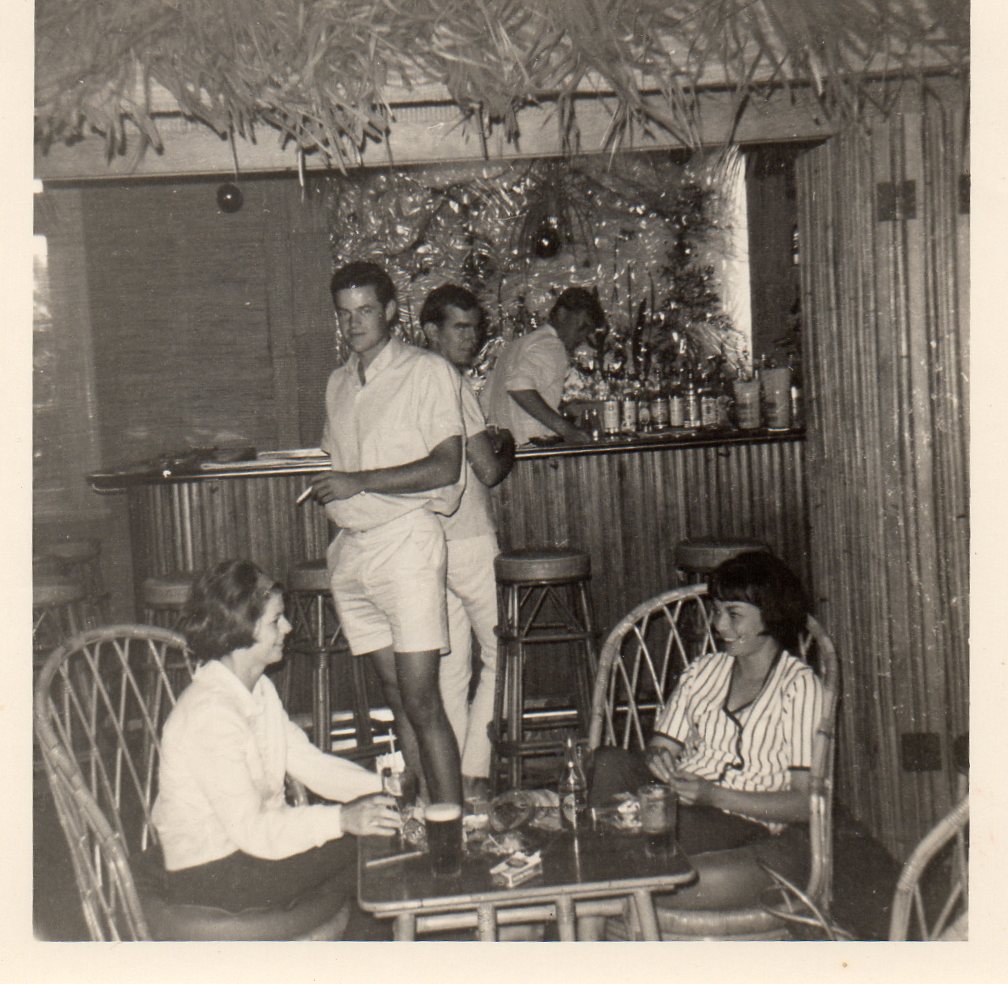
Glenys Pearson, Ron, Peter Mobbs and Ward "Pally" Austin's sister- Newport Arms 1963
What was Frank Gonsalves like?
The nicest man you could ever meet. He was a great surfer. Frank was a Boatwright -Shipwright and so could design anything. He could shape a board or build a boat – whatever he chose.
Were you around in 1956 when the Americans came out with those surfboards that could turn across the face of the wave?
No I wasn't. I do remember two that came out in the early 1960's though. There was Bob Cooper, a good surfer, and Phil Edwards, an absolute legend.
So you left the boards?
What happened was I literally jumped off a surfboard onto a horse. I loved horse racing too. Megan taught me to ride and I stared hanging out with all her friends- life does that, it takes in new directions. I was still in touch with all my surfing mates, but doing other things.
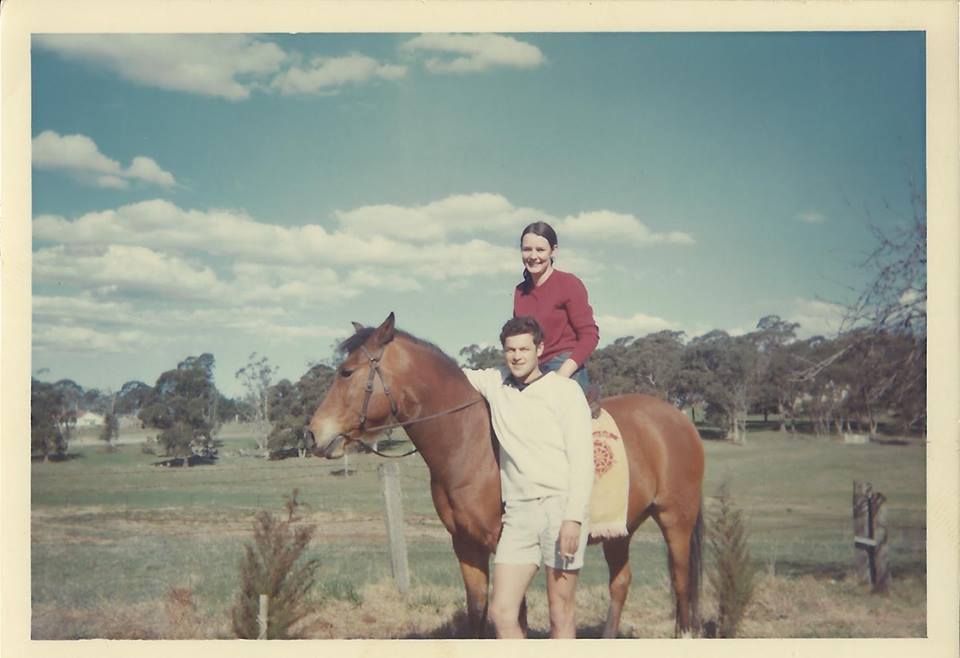
Ron and his wife to be Megan Williams and her horse Bobby 1967
I fell in love with the country. In the meantime Megan’s parents retired to Moss Vale in the Southern Highlands. I’d travel down there every second week and Megan would come up to Palmy on the alternate one.
I then got into speedway racing in the cars – I had an FC Holden, it was real hot. It had triple carburettors and an American cam – it was a rocket! I’d brought it from a man who became an Australian champion – he actually went on and got the Australian championship in a Torana. I got this through John Giddings, another bloke who used to race at Bathurst. So I was playing golf and racing my car, riding horses, was a founding member of the Bowral Blacks, the rugby union side, in 1972.
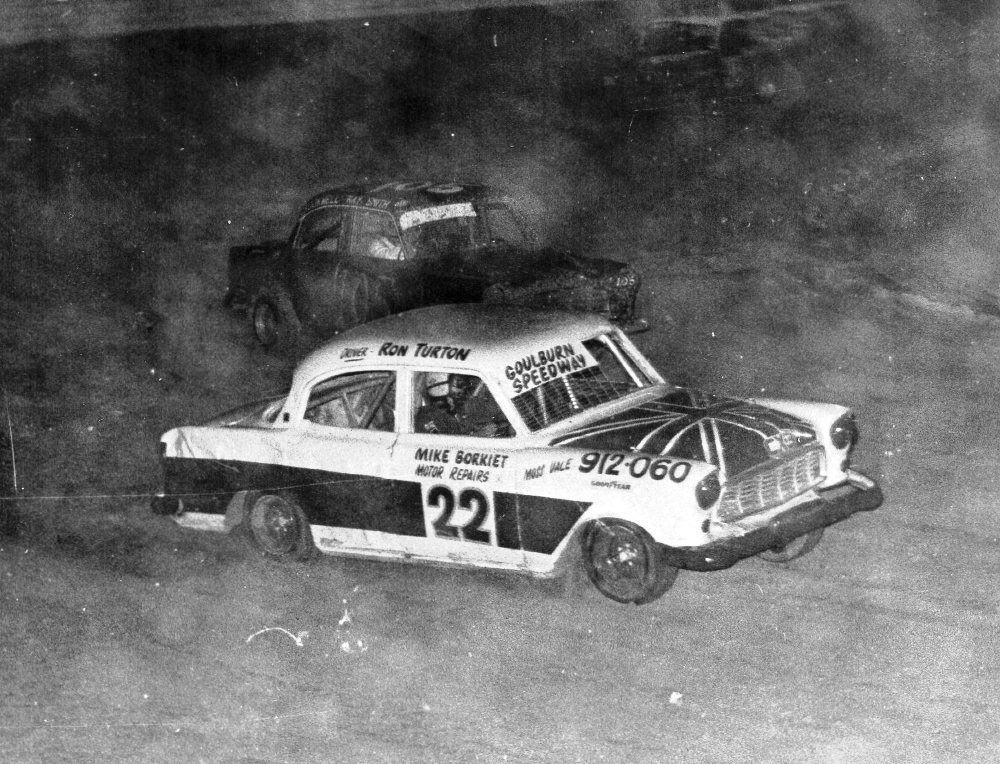
Ron charges to the lead Goulburn Speedway 1977 in his flying FC Holden. Notice the Union Jack from his English heritage. Under the bonnet was a five stage head, triple Stronberg carbys, a lightened fully balanced flywheel, X2 Clutch and a fully imported American Iskenderian cam.
Life had changed completely. I then joined the local paper in 1971 – the Berrima District Post. I’d had enough of the city; I walked into the boss at Avon and said, ‘Bevin, I’m off.’
‘Where to?’
‘The bush.’
We married in 1969 and moved.
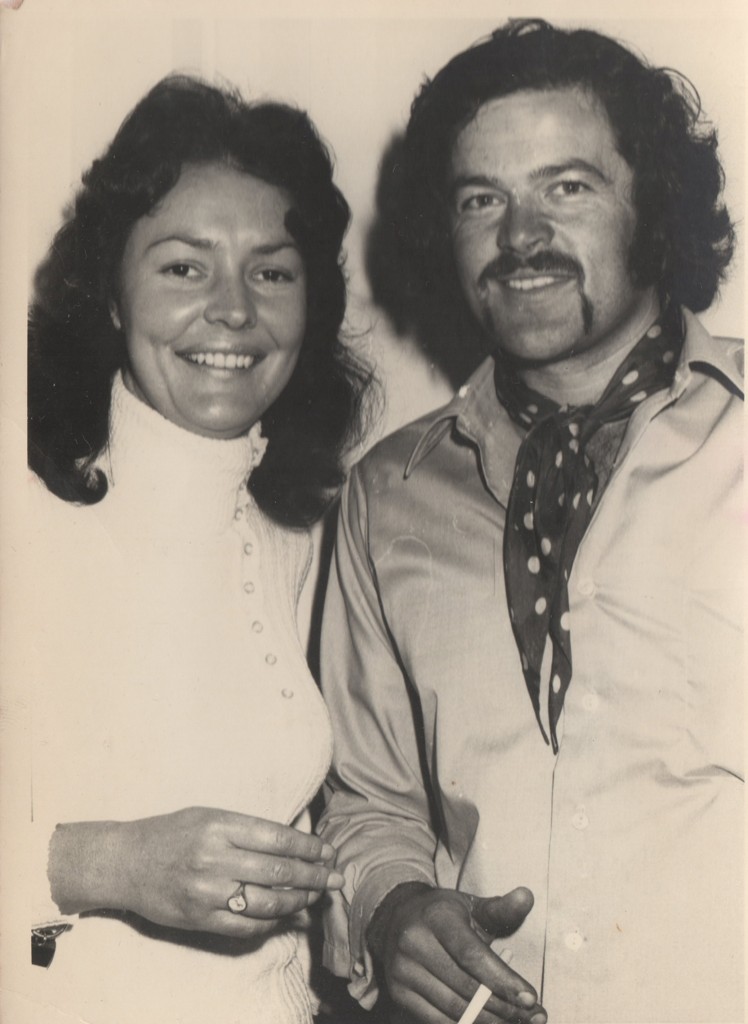
The love of my life, my wife Megan - taken at Moss Vale in 1972
At that stage I didn’t have a job. There was a job advertised in the Post,- ‘Car Detailer, - I didn’t know what that was but turned up. The bloke, John Giddings, who became one of my best mates, explained it was washing cars and asked if I had any experience at that, then that I was the only applicant and consequently got the job.
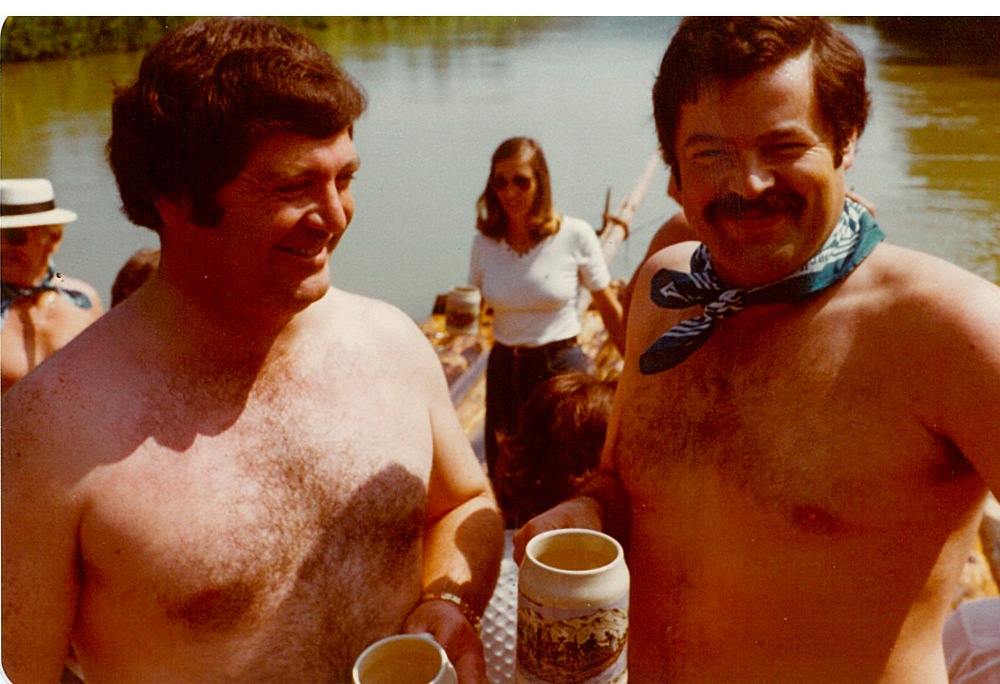
Ron and his speedway racing mate John Giddings on a junket visiting the BMW works Munich 1979.
Ron bought his first speed car from John who then went on and raced with success at Bathurst. "He was a champion bloke and we had some great times together on and off the track. He should have won Bathurst one year but his co driver walled it with only a few laps to go". John was an accomplished rally driver too however he went out doing what he liked best going over an embankment only a few years ago at Orange and sadly passed away from his injuries.
I’d started playing footy. The coach of the Bowral Blacks was John Begg, who later became Neville Wran’s press secretary, and he was the editor of the Berrima District Post. John asked me what I was doing for a job and I explained I was washing cars. He said he thought I had a few more brains than that. I was there for a week doing payroll and one day their Advertising Manager didn’t turn up. His wife wasn’t very well and he told them he had to take indefinite leave and look after her.
John said to me ‘you and Linda better go and get some advertising’. I had no experience at that either, but we got the papers associated with it, went around to all the regulars, into Bowral and I had suddenly found something I really loved to do; designing and selling advertising space.
I could draw, could write the copy, and have a bit of the ‘gift of the gab’, had been in the Debating Team at Narrabeen High, so it just worked. I could go and talk to people, get all the details of their products, they would let you design the ads for them.
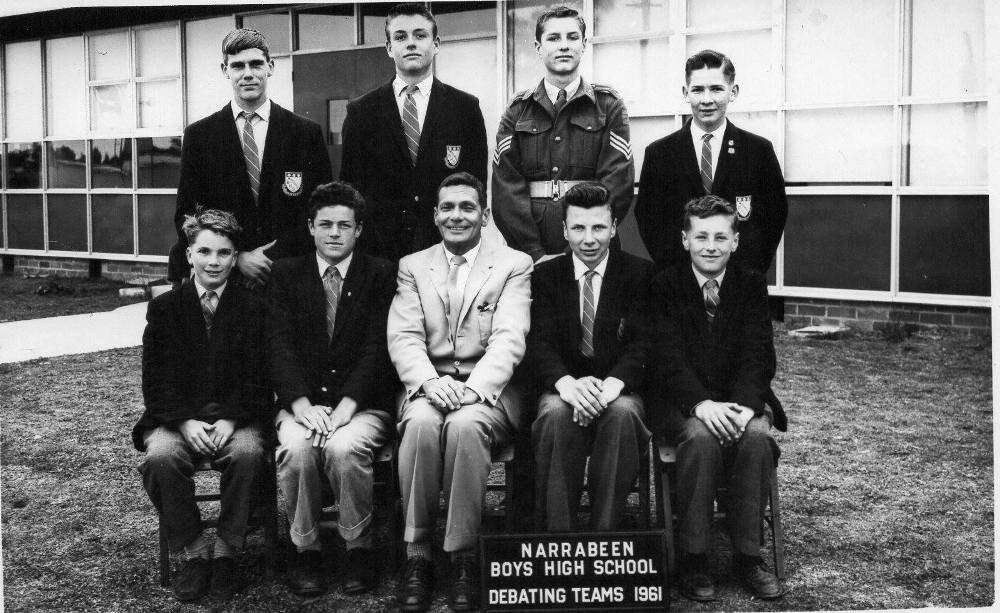
1961 Narrabeen Boys High School Debating Team - Rob Mundle, now a brilliant author, is in this picture too - bottom row, second from right. Ron is bottom row second from left. The team was Firth, Philip Smiles, Shane Kingsbury, Burton, Warren, Ron Turton, teacher Mr. Laws, Rob Mundle, Bates.
The Editor couldn’t believe it, he told me he was going to talk to the owners about going from a bi-weekly to a tri-weekly. That’s how much advertising I was bringing in. They used to call it the Moss Vale paper because Bowral had the Southern Highland News, but I thought I may as well go to Bowral too; people would say they’d never seen anyone from Moss Vale before. I was there for seven years. During that time John Begg had left and we’d had a few editors, and I was loving it, the work.
The downside was my marriage split up. I was working long hours, playing footy, playing golf, racing at speedway when I was supposed to be married.
When I was working at Avon I’d taken on a second job on the end f one of those polishing machines – it was an extra three hours work each day and the money was saved towards another board r car, or whatever. When you’re young you do these things, you grab those opportunities. I saw an opportunity to do something similar down at Moss Vale, to start a cleaning company. I then saw the then Wingecarribee Shire Council wanted a contract cleaning company and applied for it, and got it. The contract was about three times what I was getting at the paper. I stayed at the paper though. Then I got other contracts for cleaning and did alright but this love of the newspaper game stayed with me and I stayed with it.
We had a girl, Kate Wilson, who came across from Western Australia, drove across the Nullarbor on her own, and took on a job as a Cadet. We became an item but she had big plans for her future, the Berrima District Post was just a stepping stone – she wanted to go and work in Sydney. After a while she applied for a job at the Australian Women’s Weekly and got it. This was 1977 by now.
At the same time the editor, Murray McCracken, worked in the city. He was a very good sub-editor, a genius. He called me in one day and asked me where I thought I’d be when 48 or 50, I answered hopefully here – ‘what, as Advertising Manager of the Berrima District Post?
He explained he’d worked on the big metropolitan papers and in his opinion I had it, I could do much better elsewhere. He stated I could make a lot of money in a different environment.
We went up to the Country Press Awards about two weeks after this, I’d already won a few things for Ad Design and that sort of thing, and by this time the paper was tri-weekly and making a fortune. I saw an ad in the old Daily Mirror, then the top selling daily paper in New South Wales, ‘Can You Sell? If so ring Lindsay Gulliver’.
I rang him, explained I was going back to Moss Vale and he said he’d wait, and saw me after he’d finished. I went in and had my briefcase with some of my entries for the award. He said, ‘when can you start?’
So Kate got a job at the Weekly and I got a job at the Mirror.
I’d never worked in the city itself, the offices were at Surry Hills. Within 18 months I’d gone form a phone blowing ad Rep. to the Features Manager for advertising features (things like the Daily Mirror Homes Show for instance)and then Assistant Ad Manager of the Mirror. If we got the naming rights for something, such as the Motor Show at the old Sydney Showgrounds, we’d do a lift out supplement and include any of the exhibitors who wanted to be in there; we’d get a half page ad from them.
So I was meeting people like Rupert Murdoch at Board Meetings and at moments like those you remember being on a jackhammer at the Water Board!
I then thought I’d better set myself a goal, and that was to become an Ad. Manager of a Metropolitan Newspaper.
Out of the blue Rupert Murdoch’s sister’s son, Matt Handbury, who was the boss of Tamworth, asked me to make that look and run more like a newspaper. I thought he was joking; here I was two from the top in Sydney and he wanted me to go back to the bush.
Well, he leant on me…
Was he heavy?
Yeah. But only because Rupert was his uncle. He wasn’t that heavy in the weight department.
What year is this?
1981. He was relentless. But I decided to go and I hated it, hated it. I’d come from Palm Beach, had been to Moss Vale, which was also beautiful. I’d live in two of the best places in the world and Tamworth was more like a mini-city, without enough country left in it. when the Country Music Festival would run 32 thousand people would leave as 32 thousand people arrived. There wasn’t enough social life for me – I used to love the races, so there was some of that there. I joined the polo club, which was fun. I did make some nice friends there but after work everyone was at home. The only ones who stayed out were the journo’s and that was mostly just to drink – no good for me, I didn’t want to drink.
So I couldn’t get out of there quick enough. Ken Cowley, who was the 2IC (second in charge) at News Limited rang me one night and asked me how long I’d been there – 2 years, 4 months and 28 days, four hours and three minutes; I could quickly answer. We must have done ok there I was then appointed as the Advertising Manager if Murdoch’s new baby the Daily Sun in Brisbane. So I’d reached my goal.
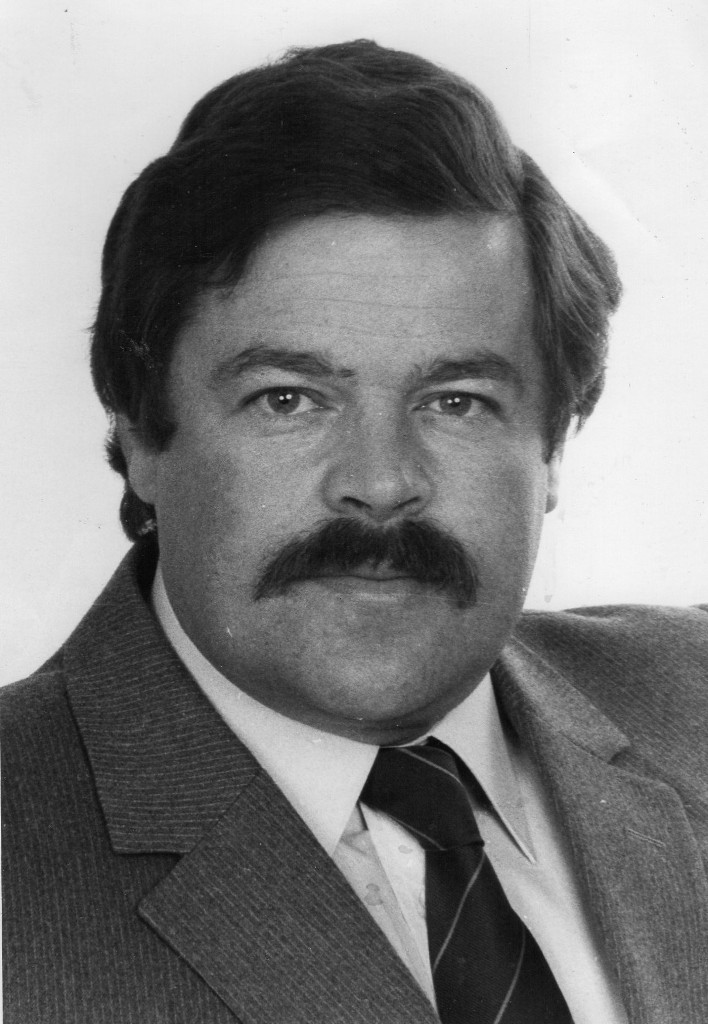
Ron in 1981. An executive with News Ltd.
Where did you live in Brisbane?
New Farm, on the river. This is just out from Fortitude Valley, where our office was. They then made me Marketing Coordinator at the Daily and the Sunday Sun – I’d become an Executive.
From a bloke that stumbled into something while washing cars I’d come a long way.
Then the Board Meetings started to drive me bonkers, I seemed to be endlessly doing Accounts, much like my days at Avon.
I kept my big Accounts, like XXXX beer, Fosters etc. but it just wasn’t the same. My promotion from Ad. Manager to higher meant I lost touch with the industry I loved. So I resigned in December 1987 and went back to England, where I was born.
What was England like years on?
I met up with all my relatives, my grandmother was still alive then, my mother’s mum, and she hadn’t seen me since I was born. Some of the reunions were pretty tearful; mum and dad had never gone back. I had so many cousins I’d never met – I had a ball over there. I was there three and a half months.
A mate of mine came over and we got a hire car and went through Wales and up to Scotland. He went on to Europe and I had time with my relatives – uncles and aunties.
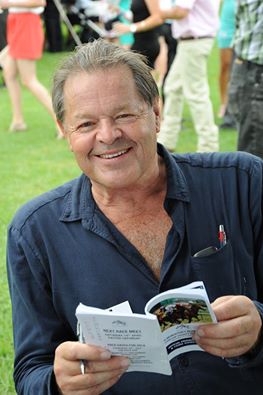 The whole time something was telling me ‘this is where you belong’. I really felt at home there, even though I was only 4 when I left. I was there during the Summer too, England is beautiful during that season, the countryside is second to none. It may have been because I never had any relatives out here – I only had mum and dad and Pearly – my brother had died when he was only 20. All my friends out here were always going off to see uncles and cousins and aunties; but I’d never had that.
The whole time something was telling me ‘this is where you belong’. I really felt at home there, even though I was only 4 when I left. I was there during the Summer too, England is beautiful during that season, the countryside is second to none. It may have been because I never had any relatives out here – I only had mum and dad and Pearly – my brother had died when he was only 20. All my friends out here were always going off to see uncles and cousins and aunties; but I’d never had that. That changed when I got back to Australia of course; I realised you can’t beat our beaches and the sunshine, the lifestyle we have here.
I came back to Brisbane, and didn’t want to go back to News Limited – I loved the country, didn’t like the city life.
I knew I had to get a job, I was only 43. Someone said there was a job at Moree for an Ad. Manager. So I got on a greyhound bus out here, was interviewed by the Editor of the Moree Champion, and he said I’d be meeting one of the owners tomorrow, which was the Saturday. The Moree Champion was privately owned then, they also had The Border News. I met the co-owner, Geoff Farrar, who explained there was no way they could meet the salary I must have earned in Brisbane. He named a figure, I knew I could live on that, and took the job.
He told me there was a race meeting that day, was aware I like racing. He had a horse running, and it won, and Jim Lemmon had a horse running, and it won. I backed them both. Geoff explained, ‘it doesn’t work like that every week mate’.
I caught the bus back, packed my gear and came back – that was in 1988. I ended up being there 26 ½ years and retired in 2014.
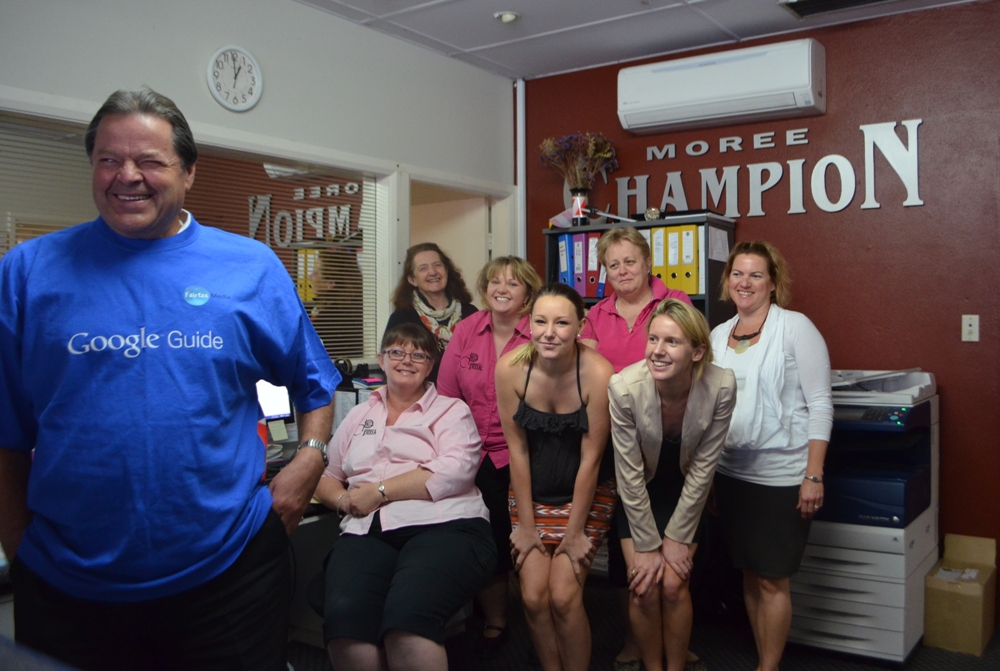
Ron entertains the girls with some Googling at The Moree Champion.
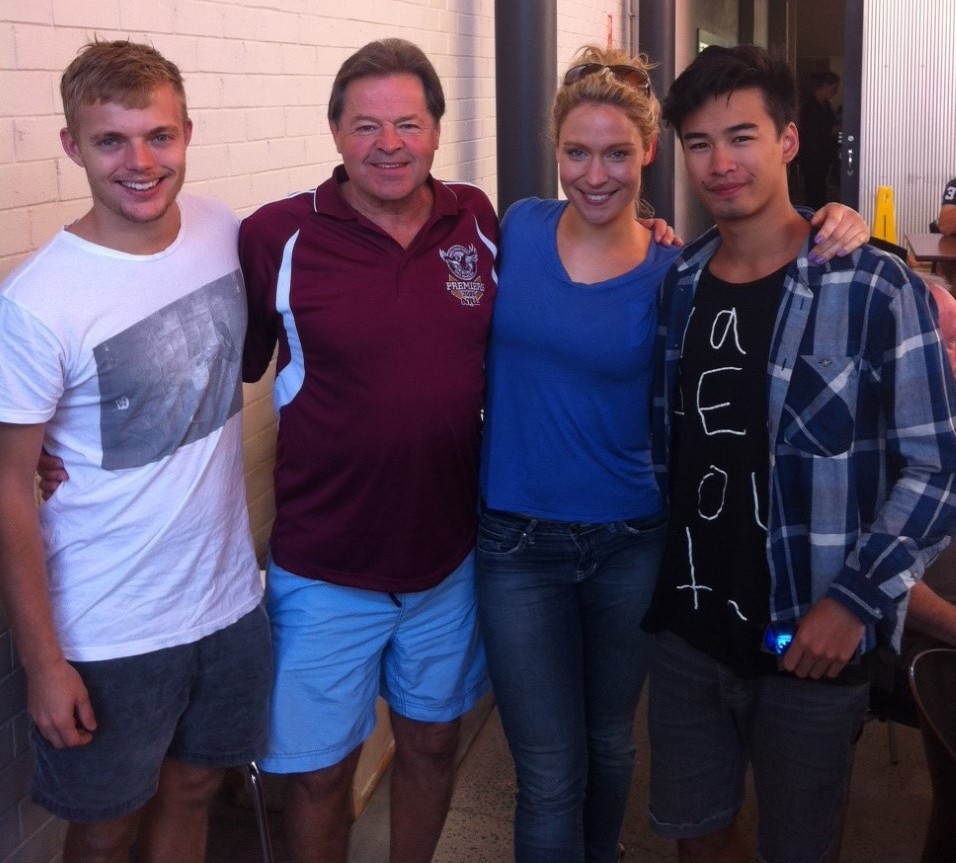
Ron & Lisa Gormley (Bianca) with other Home and Away stars Moree 2012
Ron with former Rugby League legend Mick Cronin.
I’m still here in Moree. I love the country lifestyle. I still get down to Palm Beach a couple of times each year too.
Ron's surprise retirement present Moree 2014. (Check out the Avalon Beach artwork by FEZ).
Ron says thanks for the memories (retirement party 2014) - See "Time to put your feet up Turto!" - Moree Champion, Feb. 27th, 2014
Ron - Enjoying retirement. A nice Murray Cod caught at Mungindi (NSW/QLD Border). "No more pin stripe three piece suits out here."
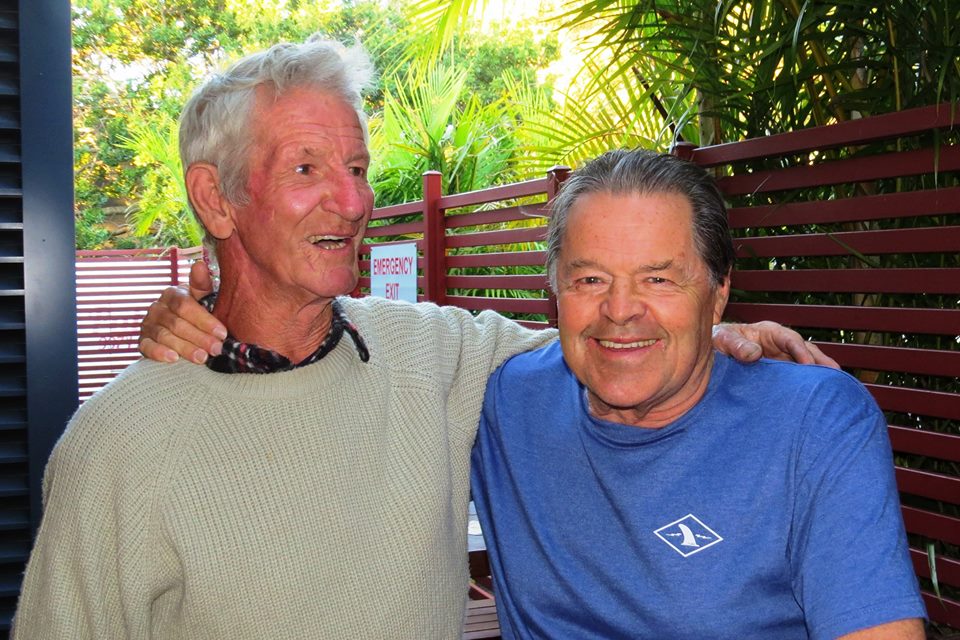 .
.Ron with one of the originals the late Barrie Webster only months before the Whale Beach legend passed away this year (Ron and Barrie are pictured in the 1954 Avalon School pic in this article).
After 43 years in the newspaper industry, what is your perspective on the digitisation of media – newspapers are getting thinner as everything goes online, which is good for the trees, and good for re-establishing democracy in the media as everyone now has a voice, but what’s happening to and in the news pulp industry?
When I started it was all the old hot metal and printing presses and linotype operators and went through the paste-up days. The linotype operators had been there for a few hundred years, which is a whole other story in itself. When the computer age came along everything was changing every five minutes.
To answer your question though; yes, the papers are getting thinner, the magazines too. To be honest, I’m sad to see the demise of newspapers. But I’ve never seen a kid walk into a paper shop and buy a newspaper, the next generation doesn’t do it. But I don’t think there’s the money in the online media that there was in newspapers – I remember when you wanted to buy a full page add in the Mirror, even back in the late 1970’s, you’d be looking at 40 thousand dollars – nothing like that will ever happen online.
What are your favourite places in Pittwater and why?
I never get sick of looking at Palm Beach lighthouse, so Barrenjoey Headland and Lion Island. I think from The Basin out to the island is the most spectacular waterway in the world.
If you get up on Sunrise Hill and look around from that angle – that’s just beautiful.
What is your ‘motto for life’ or a favourite phrase you try to live by?
What I’ve learnt I’ve passed on to others.
This stems from the Manly Boys High motto originally and has stuck with me. This means whatever I learnt I passed onto others, especially my crew as this made a strong team.
Latin: Capimus Sed Tradimus
(What We Receive, We Pass On)
I also like ‘Better to remain silent and be regarded a fool than to open your mouth and remove all doubt.
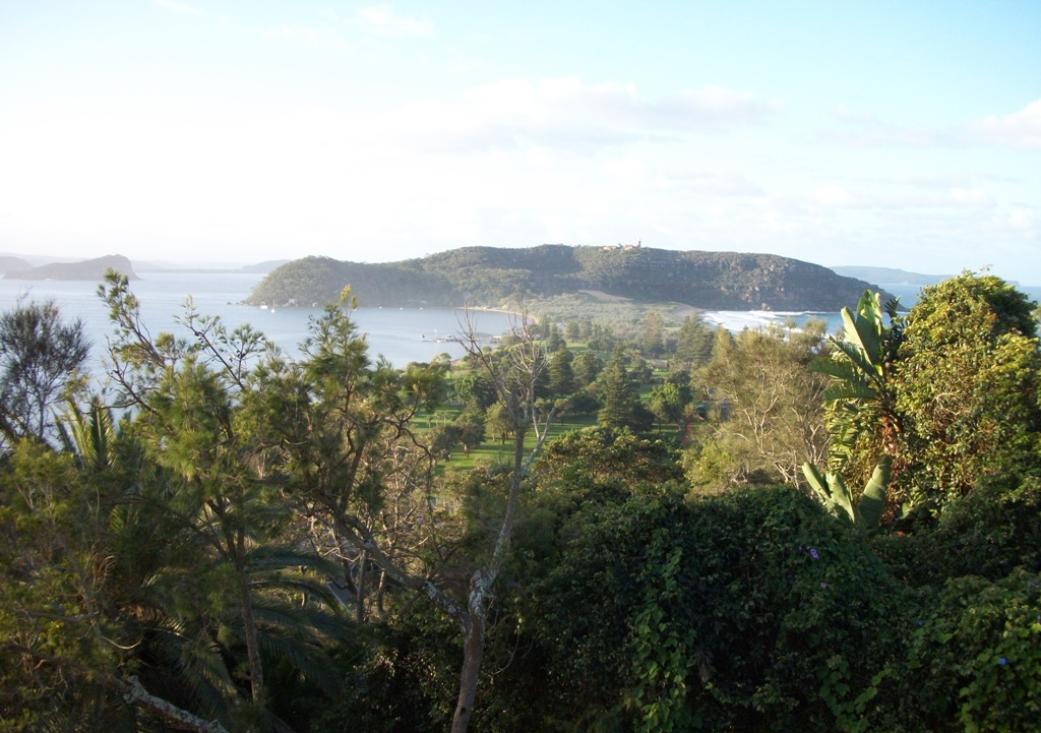
Barrenjoey Headland, Lion Island and Palm Beach Golf Course from Sunrise Hill - A J Guesdon picture.
Notes and Extras
NARRABEEN SITE FOR SCHOOL
The Warringah Shire Council and the Education Department are to negotiate about a High school site at Narrabeen.
The president of the council, Councillor Batho, said last night that diversion of opinion between the Manly Council and Warringah Shire about a site had delayed the building of a High school.
The proposed site at Narrabeen was ideal, he said. However, districts having the greatest population should determine the site. NARRABEEN SITE FOR SCHOOL (1947, August 6). The Sydney Morning Herald (NSW : 1842 - 1954), p. 4. Retrieved from http://nla.gov.au/nla.news-article18047991
NARRABEENS HIGH SCHOOL
Extensive use of glass, combined with modern construction techniques, has given the new Narrabeen Boys' High School a very pleasing but nevertheless functional appearance. Eight single-storey prefabricated aluminium-frame buildings provide accommodation for 1,000 pupils from First -Year to Leaving Certificate standard. The importance of. natural lighting is emphasised in all buildings by the installation of aluminium curtain walls with clear glass, plate glass sections at the ends of the building and rough cast glass highlights in the aluminium roof. A colourful exterior is provided with attractive vitreous enamel panels in greens and reds on the lower portion of the curtain walls. Amenities include sheltered lunch rooms for wet weather, changing rooms with hot and cold ^showers and covered ways between the buildings. Internally the buildings are permanently divided into classrooms, with some folding partitions for provision for larger room areas. Designed by H. Stossel, the school was erected in 20 weeks by James S. Sampson, a subsidiary of Hawksley Australia Pty. Ltd. The glazing was carried out by Bromley Simpson and Co. Pty. Ltd. NARRABEEN'S HIGH SCHOOL (1959, June 10). The Cumberland Argus (Parramatta, NSW : 1950 - 1962), p. 11. Retrieved from http://nla.gov.au/nla.news-article131616238
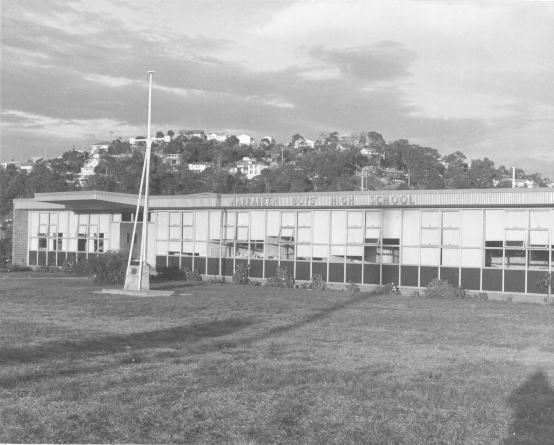
Narrabeen High School - 1959 - Image courtesy NSW Dept. Of Education.
Mosquitos in Australia – Book, Ron Turton Snr DFC is the smiling one in this photo within this book.
A Most Secret Squadron – Book
No. 618 Squadron RAF
No. 618 Squadron RAF was a squadron of the Royal Air Force during the Second World War, intended to carry of a variation of the Barnes Wallis designed Bouncing bomb code-named "Highball". Due to various circumstances the "Highball" weapon was never used and the squadron disbanded at the end of the war.
Formation No. 618 Squadron was first formed at RAF Skitten on 1 April 1943, as part of No. 18 Group of Coastal Command, from crews of No. 105 Squadron RAF and No. 139 Squadron RAF. The unit was initially equipped with Beaufighter Mk.II fighter-bombers, but quickly changed to converted Mosquito Mk.IVs.
The Highball
The "Highball" device was intended to bounce across the sea until it hit an enemy ship, sank and exploded. Unlike the cylindrical Upkeep weapon used by No. 617 Squadron RAF in Operation Chastise, the "Highball" was more spherical. The Mosquito selected for the conversion work to carry "Highball" was the Mk.IV series II: the work entailed removing the bomb bay doors and equipping the aircraft with specialised carriers enabling them to carry two "Highballs", each weighing 1,280 lb (580 kg), in tandem. The bombs were designed to skip across water and to provide weapon stability and accuracy. Before release they were spun backwards at 700 to 900 rpm by a ram air turbine mounted in the bomb bay's midsection, fed by an extendable air scoop. The bombs were to be dropped from a maximum altitude of 60 ft (20 m) at a speed of 360 mph (600 km/h).
In the event, through lack of weapons, training and aircraft, No. 618 Squadron was kept frustratingly inactive and never attacked the Tirpitz. Instead the unit was selected for carrier-borne operations in the Pacific.
For this role 25 Mosquito B.Mk.IVs were further modified:
- Each aircraft was equipped with Merlin 25s, adapted to provide peak power at low altitudes, driving four-bladed Rotol propellers: these propellers had narrower blades than the standard three-bladed units, meaning that the engines would rev up faster and respond quicker to throttle movement, factors vital in the limited length of carrier takeoffs.
- Longer intakes under the engine cowlings were fitted with tropical filters.
- The undercarriage legs were made of heavier-gauge metals and the wheels were fitted with the twin brake units of FB Mk VIs.
- The rear fuselages were structurally modified with a special internal longeron and reinforced bulkheads designed to take the additional loads imposed by carrier landings: an additional bulkhead (No. 5a) was fitted.
- Externally a "V-frame" arrestor hook was fitted. The "snap gear" which released the hook was operated by a Bowden cable from a lever mounted on the cockpit port side.
- An access hatch was moved from the starboard rear fuselage to underneath, and an extra longitudinal stiffening strake, identical to that already fitted to the starboard side of production Mosquitos, was fitted to the port fuselage.
- The tailwheel fork pivots incorporated end plates to avoid being caught in the arrestor cables.
- Armoured windscreens were fitted, along with hydraulic wipers.
- Three PR.Mk.XVIs, which were to be used for reconnaissance duties were also fitted with the four-bladed propellers and fuselage modifications for carrier operations.
UK squadron movements
The squadron's primary target was designated as the Kriegsmarine Surface Fleet, primarily the battleship Tirpitz, so the squadron remained training in Scotland and waiting for the Surface Fleet to sortie into the North Sea until July 1944, when this threat had lessened. As a matter of fact the German Surface Fleet never emerged from its bases in Norway. In the meantime the squadron had moved to RAF Wick, and re-equipped with Mosquito Mk. VIs and No. 618 Squadron did not have had the opportunity to use the "Highball" weapon. In August 1944, the squadron deployed to RAF Beccles in Suffolk, and in September changed aircraft again to Mosquito Mk.XVIs. The squadron deployed to RAF Benson in September, transitioning to Mosquito Mk.XVIIIs in October.
Australian deployment
In December 1944, No. 618 Squadron was deployed to Australia for carrier-borne operations, as Japanese targets for the "Highball" weapon were still available there. These Mosquitos were transported to Australia on board the carriers HMS Fencer and Striker, arriving on 23 December 1944, subsequently sent to the de Havilland Australia's Mascot, Fisherman's Bend aircraft factory for reassembly. In order to keep up aircrew proficiency and safeguard the modified Mosquitos, 12 disassembled FB Mk VIs were also sent, arriving in Sydney in February 1945. Training began at Narromine that month A detachment was sent to British Pacific Fleet base at Manus Island in March, but the squadron was unable to go into action against Japanese shipping, mostly because there was no target left in the area anymore.
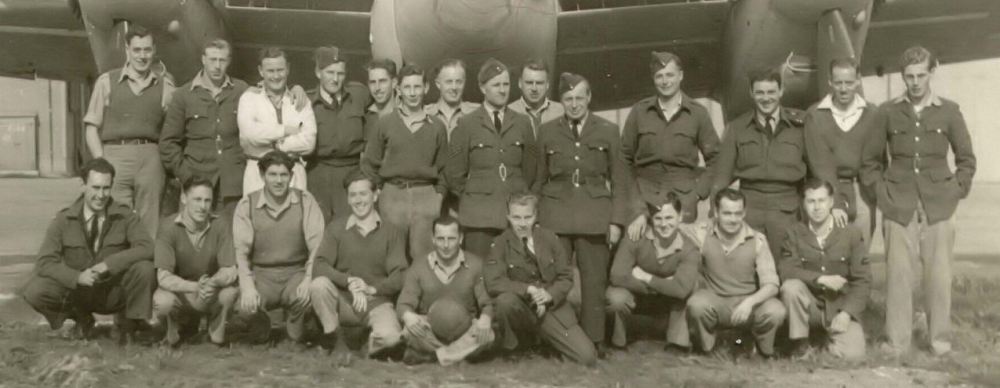
Close up of Mosquito FB.VI fighter-bomber of 618 Squadron RAF after assembly at Mascot, destined for Narromine. Photo courtesy Roley Manning
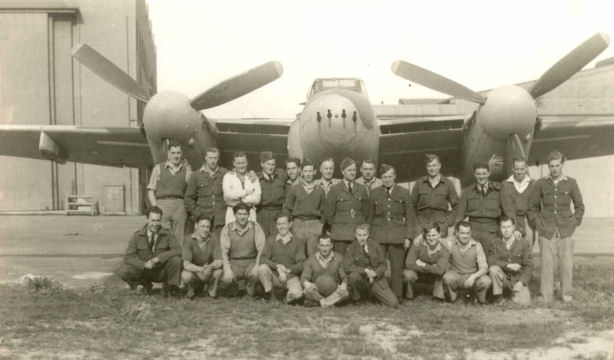
Due to political-strategic infighting between the British Pacific Fleet and the U.S. military, the unit was never in action, and was disbanded (officially) at RAAF Narromine on 14 July 1945. The converted Mosquitos were stripped of all military equipment and sold off. The sole surviving No. 618 Squadron Mosquito, an FB. Mk.VI HR621, is currently undergoing restoration at the Camden Aviation Museum, NSW.
No. 618 Squadron RAF. (2015, August 23). In Wikipedia, The Free Encyclopedia. Retrieved from https://en.wikipedia.org/w/index.php?title=No._618_Squadron_RAF&oldid=677507096